Physical Address
304 North Cardinal St.
Dorchester Center, MA 02124
This chapter describes the broad scope of hand surgery. It emphasizes core knowledge that is important to general surgeons. The origins of this important subspecialty are rooted within general surgery. It is a regional specialty bringing together general, plastic, and orthopedic principals.
Although hand surgery fellowships traditionally receive trainees primarily with backgrounds in orthopedic surgery or plastic surgery, fellowship training in hand surgery may also be undertaken by those having completed a residency in general surgery. Basic tenets of hand surgery must be acquired by all general surgeons. Depending on the practice locale (rural or urban), type of hospital, and residency rotations (e.g., surgical intern covering the emergency department) or even for the purposes of board examinations, the ability to evaluate and to manage hand injuries and problems is a necessary skill for the general surgeon. The purpose of this chapter is not to provide the general surgeon with an exhaustive study of hand surgery, because specialty texts are more appropriate, but to provide an overview of pathologic processes of the hand encountered more commonly by the general surgeon and especially to emphasize basics in anatomy, physical examination, and treatment of common hand and upper extremity emergencies.
Interestingly, there is a modest amount of recent literature on the quality and duration of hand fellowship training. In a recent survey to which 80% of program directors responded, the majority thought that a 1-year fellowship was still sufficient training despite the increasing breadth of knowledge in the field and new technological developments. However, programs needed to evaluate their own training to highlight areas that may need enhancement. Nonetheless, many training programs admittedly remain deficient in areas, especially shoulder and elbow, replantation, brachial plexus, congenital, and flap surgery.
The arm and hand are divided into volar, or palmar, and dorsal aspects. Distal to the elbow, structures are termed radial or ulnar to the middle finger axis rather than lateral and medial, respectively, because with forearm pronation and supination, the latter terms become confusing. The nomenclature of digits has become standardized. The hand has five digits, namely, the thumb and four fingers (the thumb is not called a finger). The four fingers are respectively termed the index, long (middle), ring, and small (little) fingers. The use of numbers to designate digits is no longer accepted ( Fig. 70.1 ). Within the hand, those structures close to the fingertips are termed distal, whereas those farther up toward the wrist are termed proximal. Motion in a palmar direction is flexion, whereas dorsal motion is termed extension. Finger motion away from the long finger axis is termed abduction, whereas motion toward the axis of the long finger is termed adduction. The description of the motion of the thumb is sometimes confusing. Extension of the thumb is in the plane of the palm of the hand, whereas palmar abduction of the thumb is the motion that occurs at 90 degrees away from the plane of the palm. Finally, side to side motion of the wrist is termed radial and ulnar deviation.
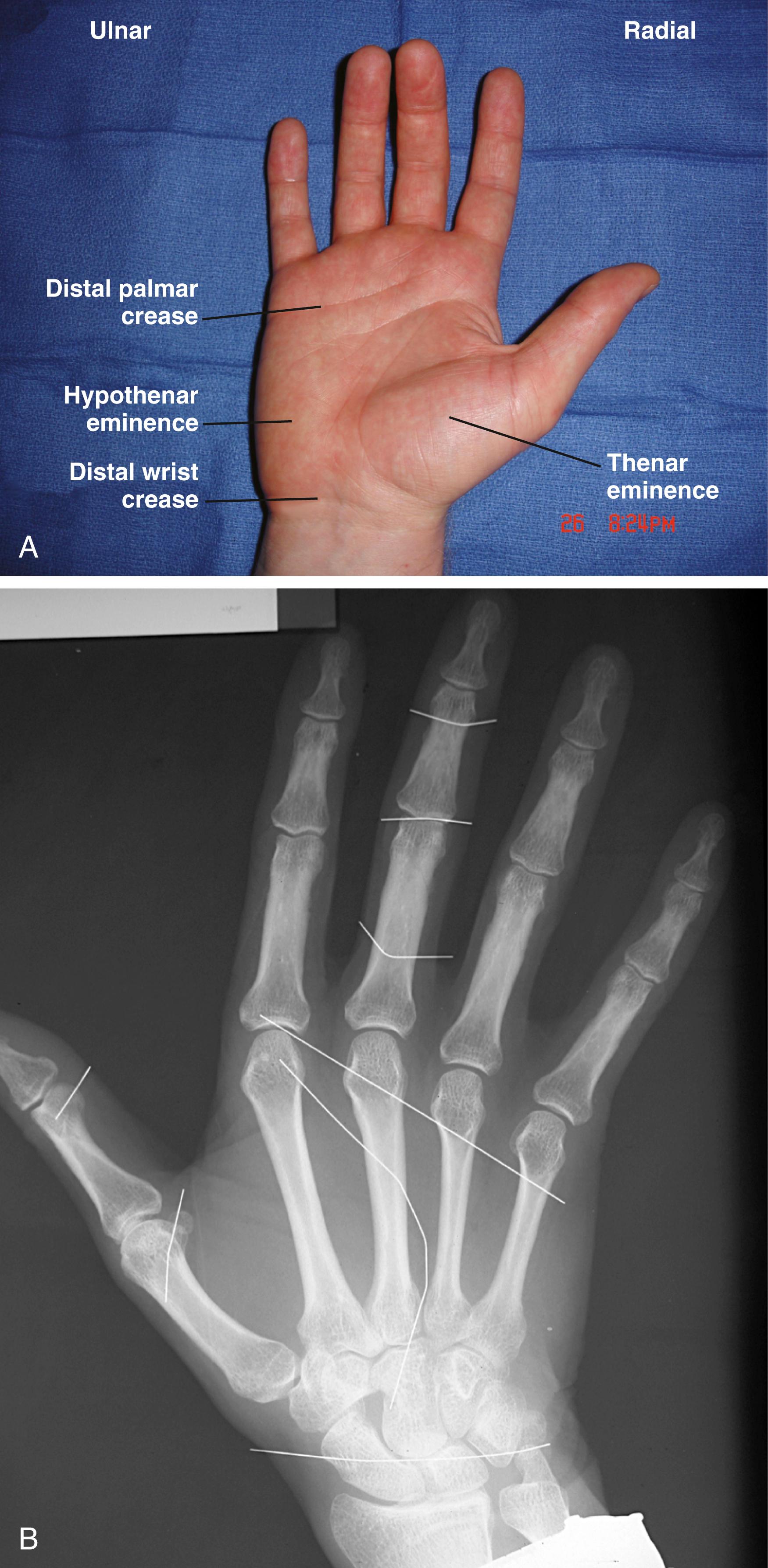
Intrinsic muscles of the hand are those that have their origins and insertions in the hand, whereas the extrinsic muscles have their muscle bellies in the forearm and their tendon insertions in the hand. The intrinsic muscles that make up the thenar eminence are the abductor pollicis brevis, flexor pollicis brevis, opponens pollicis, and adductor pollicis. There are four dorsal interossei that arise from adjacent sides of each metacarpal and provide abduction of the metacarpophalangeal (MP) joints of the index, middle, and ring fingers. There are three palmar interossei that adduct the index, ring, and little fingers toward the middle finger. Four lumbricals originate on the flexor digitorum profundus (FDP) tendons in the palm and insert on the radial sides of the extensor mechanisms of the four fingers. Together with the interossei, these bring about flexion of the MP joints and extension of the interphalangeal (IP) joints of the fingers ( Fig. 70.2 ). The flexor pollicis brevis flexes the thumb at the MP joint in contrast with the extrinsic flexor pollicis longus (FPL), which flexes the thumb at the IP joint.
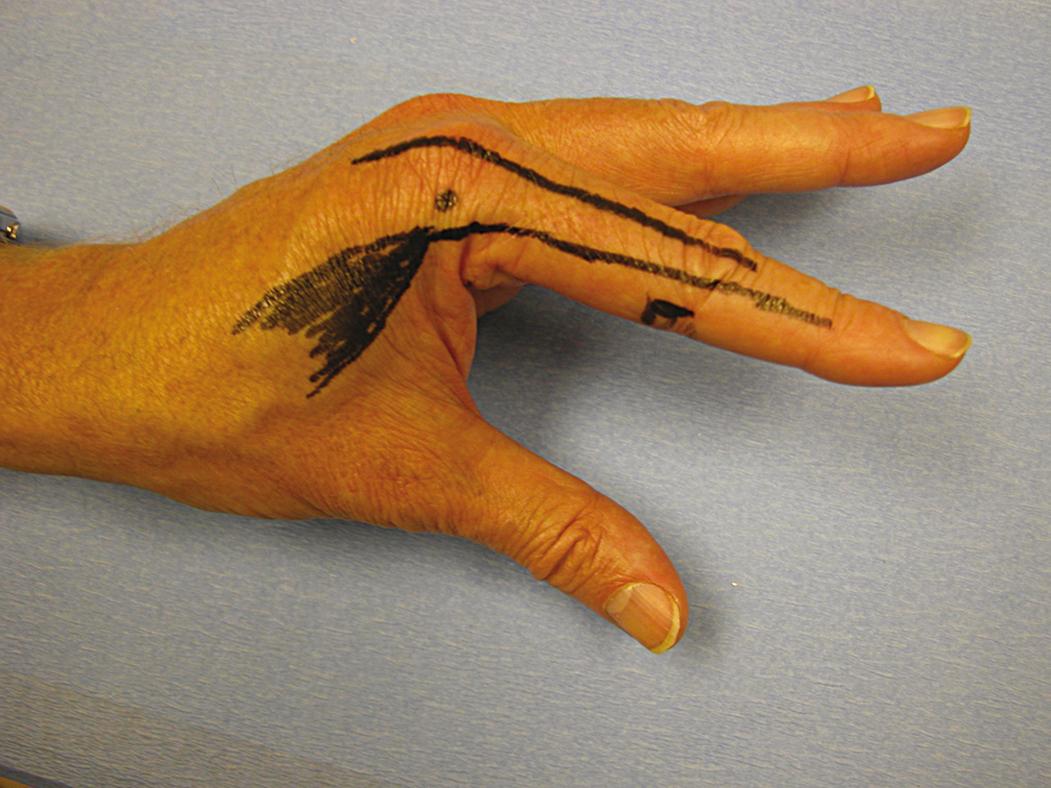
The hypothenar muscles consist of the flexor digiti minimi, which flexes the little finger at the MP joint, and the abductor digiti minimi and opponens digiti minimi. A small muscle called the palmaris brevis is located transversally in the subcutaneous tissue at the base of the hypothenar eminence. It is innervated by the ulnar nerve, puckers the skin, and helps in cupping the skin of the palm during grip ( Table 70.1 ).
| Muscle | Innervation ∗ | Function |
|---|---|---|
| Abductor pollicis brevis | Median | Abducts the thumb |
| Flexor pollicis brevis | Median | Flexes the thumb |
| Opponens pollicis | Median | Opposes the thumb |
| Lumbricals | Median and ulnar | Flex MP joints and extend IP joints |
| Palmaris brevis | Ulnar | Wrinkles the skin on the medial (ulnar) side of the palm |
| Adductor pollicis | Ulnar | Adducts the thumb |
| Abductor digiti minimi | Ulnar | Abducts the small finger |
| Flexor digiti minimi | Ulnar | Flexes the small digit |
| Opponens digiti minimi | Ulnar | Opposes the small finger |
| Dorsal interossei | Ulnar | Abduct the fingers; flex MP joints and extend the IP joints |
| Palmar interossei | Ulnar | Adduct the fingers; flex MP joints and extend the IP joints |
∗ All the thenar intrinsic muscles are supplied by the median nerve except the adductor pollicis; all the remaining intrinsic muscles are supplied by the ulnar nerve except the two radial lumbricals.
The extrinsic muscles originate proximal to the wrist and comprise the long flexors and extensors of the wrist and digits. The extensors are located dorsally and are divided into three subgroups. The radial most subgroup is termed the mobile wad and comprises the brachioradialis, extensor carpi radialis longus (ECRL), and extensor carpi radialis brevis (ECRB). The ECRL and ECRB extend the wrist and deviate it radially. The second group is located in a more superficial layer and comprises three muscles, namely, the extensor carpi ulnaris (ECU), extensor digiti minimi (EDM), and extensor digitorum communis (EDC). The ECU deviates the wrist in an ulnar direction and extends the wrist, whereas the EDM and EDC extend the MP joints of the fingers. The third and deeper subgroup comprises four muscles, three of which act on the thumb; the remaining muscle influences the index finger. The abductor pollicis longus (APL), extensor pollicis longus (EPL), and extensor pollicis brevis (EPB) provide function to the thumb, and the extensor indicis proprius (EIP) extends the MP joint to the index finger. Last of the deep muscles is the supinator, which is located proximally in the forearm ( Table 70.2 ).
| Muscle | Innervation ∗ | Function |
|---|---|---|
| Extensor pollicis brevis | Radial | Abducts the hand and extends the thumb at the proximal phalanx |
| Abductor pollicis longus | Radial | Abducts the hand and thumb |
| Extensor carpi radialis longus | Radial | Extends and radially deviates the hand |
| Extensor carpi radialis brevis | Radial | Extends and radially deviates the hand |
| Extensor pollicis longus | Radial | Extends the distal phalanx of the thumb |
| Extensor digitorum communis | Radial | Extends the fingers and the hand |
| Extensor indicis proprius | Radial | Extends the index finger |
| Extensor digiti minimi/quinti | Radial | Extends the small finger |
| Extensor carpi ulnaris | Radial | Extends and ulnarly deviates the wrist |
| Supinator | Radial | Supination |
| Brachioradialis | Radial | Flexes the forearm |
∗ All muscles of the dorsal forearm are innervated by the radial nerve and its respective branches.
The extensor tendons pass through six compartments deep to the extensor retinaculum at the dorsum of the wrist. From the radial to the ulnar side, these tendons and compartments are arranged as follows. The first compartment contains the APL and EPB, which also forms the radial boundary of the so-called anatomic snuffbox. The second compartment consists of the ECRL and ECRB, and the third compartment (which also forms the ulnar boundary of the anatomic snuffbox) contains the EPL. The EIP and EDC pass through the fourth compartment, and the EDM passes through the fifth compartment, where they overlie the distal radioulnar joint. The sixth compartment contains the ECU ( Fig. 70.3 ) ( Extensor Compartments).
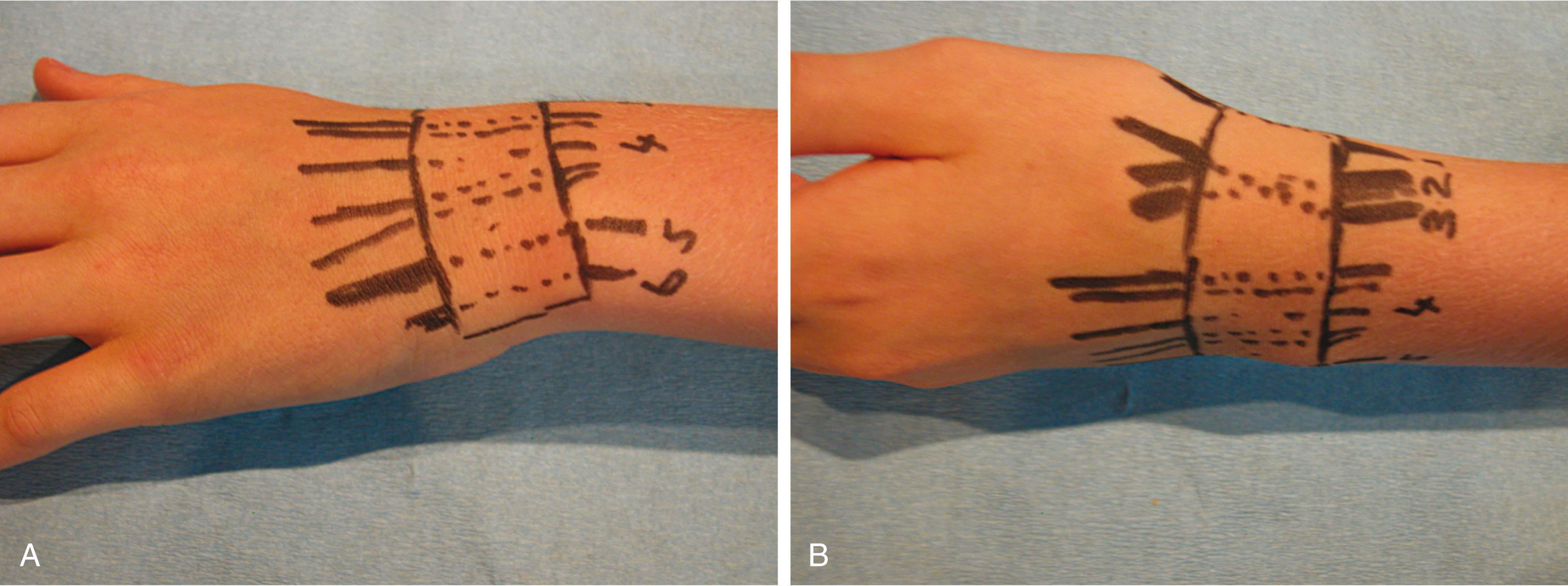
Extensor Compartments
At the level of the MP joints, the long extrinsic extensor tendons broaden out to form the extensor hood. The proximal part of the hood at this level is called the sagittal band. It loops around the MP joint and blends into the volar plate, thus forming a lasso around the base of the proximal phalanx, through which it extends the MP joint. The insertions of the interossei and lumbricals enter into the extensor hood as the lateral bands. These lateral bands insert distally and dorsally to the axis of the proximal IP (PIP) joint, and it is through this distal insertion that the intrinsic muscles (the interossei and lumbricals) are flexors of the MP joints and yet extensors of the IP joints. The extensor hood inserts to the base of the middle phalanx, which is termed the central slip, and finally proceeds on to the base of the distal phalanx, where it inserts through the terminal slip, thus extending the distal IP (DIP) joint ( Fig. 70.4 ) ( Dorsal Hood).
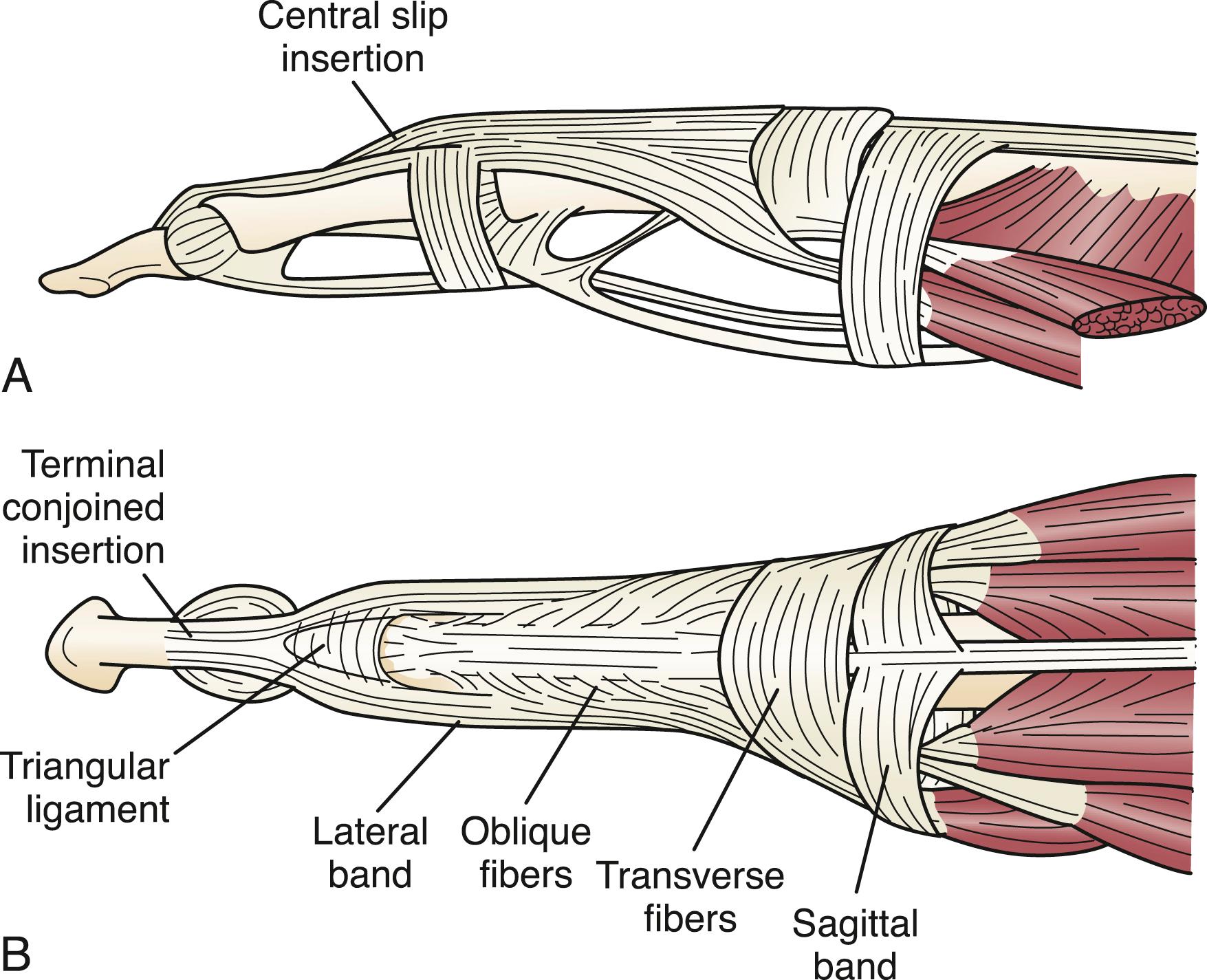
Dorsal Hood
The extrinsic flexor muscles are located on the volar aspect of the forearm and are arranged in three layers. The superficial layer comprises four muscles—pronator teres, flexor carpi radialis (FCR), flexor carpi ulnaris (FCU), and palmaris longus. The palmaris longus muscle may be absent in as many as 10% to 12% of individuals. These muscles originate from the medial humeral epicondyle in the proximal forearm and function to flex the wrist and to pronate the forearm. The intermediate layer consists of the flexor digitorum superficialis (FDS), which allows independent flexion of the PIP joints of the fingers. In the deep layer, there are three muscles: the FPL, which flexes the IP joint to the thumb; the FDP, which flexes the DIP joints of the fingers; and a distal quadrangular muscle that spans between the radius and ulna, termed the pronator quadratus, which helps in pronation of the forearm ( Table 70.3 ) ( Flexor Tendons and Pulley System).
| Muscle | Innervation ∗ | Function |
|---|---|---|
| Pronator teres | Median | Pronation |
| Flexor carpi radialis | Median | Flexion and radial deviation of the wrist |
| Palmaris longus | Median | Flexion of the wrist |
| Flexor carpi ulnaris | Ulnar | Flexion and ulnar deviation of the wrist |
| Flexor digitorum superficialis | Median | Flexion of the proximal interphalangeal joint |
| Flexor digitorum profundus | Median and ulnar | Flexion of the distal interphalangeal joint |
| Pronator quadratus | Median | Pronation |
| Flexor pollicis longus | Median | Flexion of the thumb |
∗ All muscles of the volar forearm are innervated by the median nerve and its branches except the two ulnar digits of the flexor digitorum profundus and flexor carpi ulnaris, which are innervated by the ulnar nerve.
Flexor Tendons and Pulley System
Nerve supply to the hand is by three nerves, the median, ulnar, and radial nerves. A knowledge of the surface anatomy of nerves helps in evaluation of specific lacerating injuries ( Fig. 70.5 ). The ulnar attachment to the flexor retinaculum is to the pisiform and hook of the hamate, and the radial attachment is to the scaphoid and ridge of the trapezium. The median nerve passes through the carpal tunnel between these landmarks. It gives sensation to the thumb, index finger, middle finger, and radial half of the ring finger. The palmar cutaneous branch of the median nerve originates from its radial side 5 to 6 cm proximal to the wrist, providing sensation to the palmar triangle. The ulnar nerve travels to the radial side of the pisiform and passes to the ulnar side of the hook of the hamate in its passage through Guyon canal. It gives sensation to the little finger and ulnar half of the ring finger; the dorsal branch of the ulnar nerve (arising proximal to the wrist and curving dorsally around the head of the ulna) supplies the same digits on their dorsal aspects. The superficial radial sensory nerve emerges from under the brachioradialis in the distal forearm, dividing into two or three branches proximal to the radial styloid that then proceed in a subcutaneous course across the anatomic snuffbox, innervating the skin of the dorsum of the first web space. The number of fingers served by each nerve is variable. However, as an absolute rule, the palmar surfaces of the index and little fingers are always served by the median and ulnar nerves, respectively.
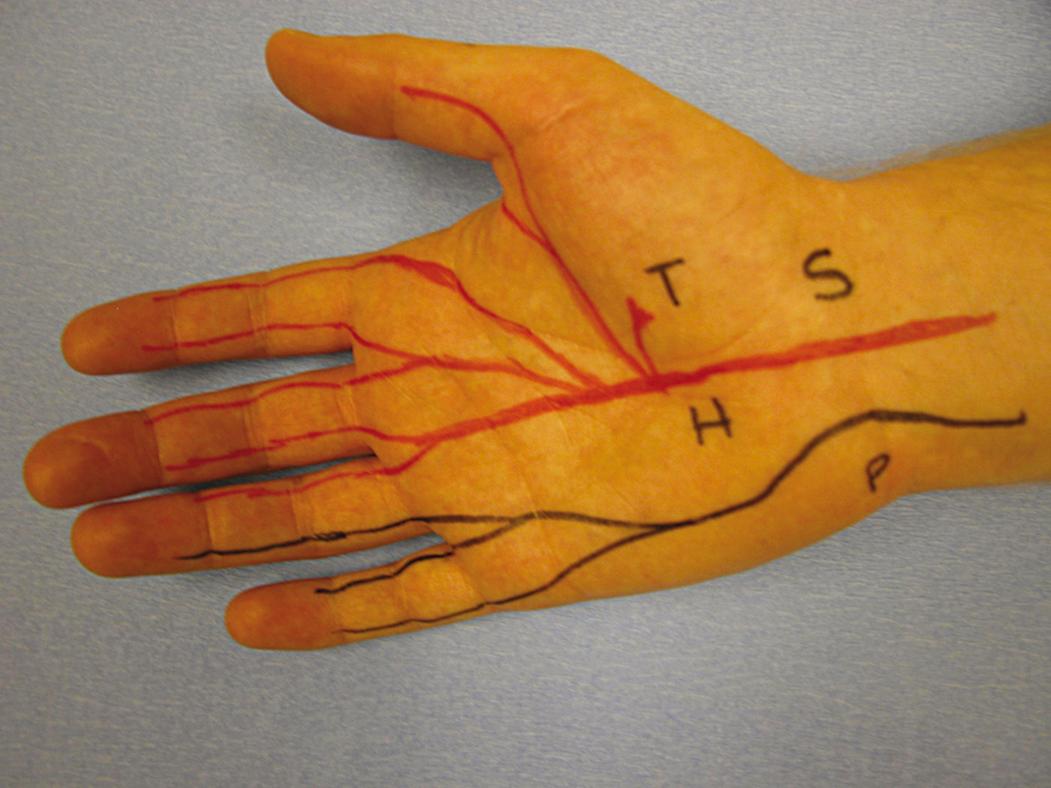
With regard to the motor supply of these nerves, the ulnar nerve supplies the hypothenar muscles, interossei, ulnar two lumbricals, adductor pollicis, and deep head of the flexor pollicis brevis. The median nerve supplies the abductor pollicis brevis, opponens pollicis, radial two lumbricals, and superficial head of the flexor pollicis brevis. In summary, the median nerve thus supplies all the extrinsic digit flexors and wrist flexors (except the FDP to the ring and little fingers and the FCU, which are supplied by the ulnar nerve) and all the thumb intrinsic muscles (except the adductor pollicis, which is innervated by the ulnar nerve). The ulnar nerve supplies all the interossei, all the lumbricals (except the radial two, which are supplied by the median nerve), and the adductor of the thumb. The radial nerve innervates all of the wrist, finger, and thumb extrinsic long extensors.
Basic instruments used in hand examination are shown in Fig. 70.6 . Examination of the resting posture of the hand can provide valuable information; for example, if a finger flexor tendon is severed, that affected finger does not assume its normal resting position in line with the natural flexion cascade of the adjacent digits ( Fig. 70.7 ). Extensor tendon injuries may be indicated by a droop at the affected joint. A clawed posture of the little and ring fingers may be characteristic of an ulnar nerve injury ( Fig. 70.8 ). Absence of sweating at the fingertips may imply a nerve injury in that particular distribution. Swelling and erythema may indicate a hand infection, and a purulent flexor tenosynovitis always results in a flexed posture of the digits. Rotational and angular digital deformities may occur when there are underlying fractures.
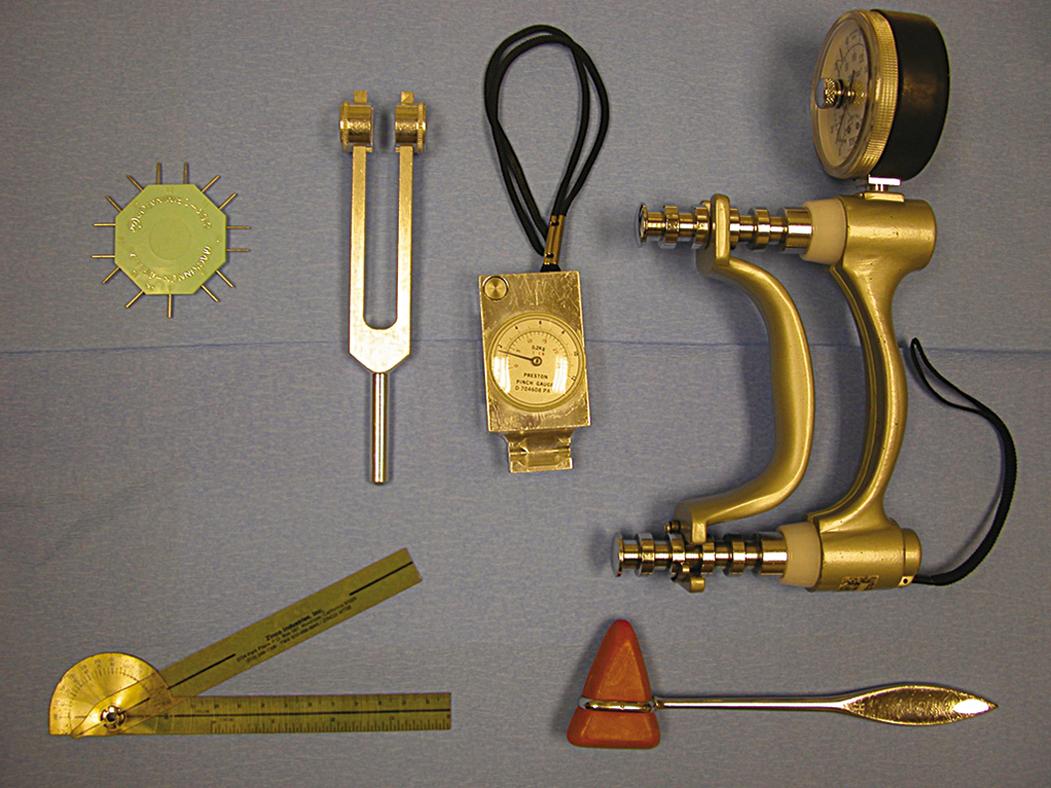
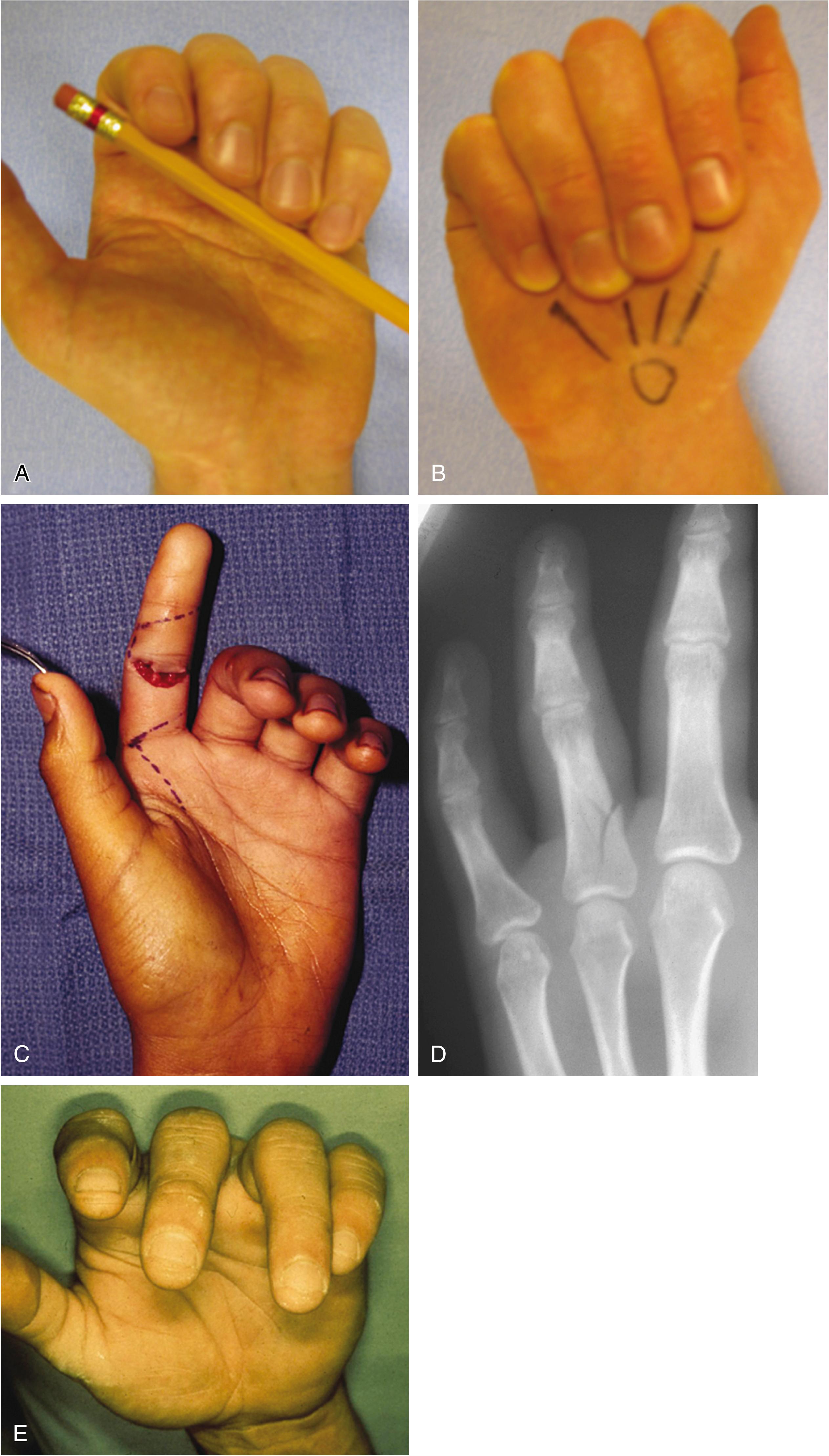
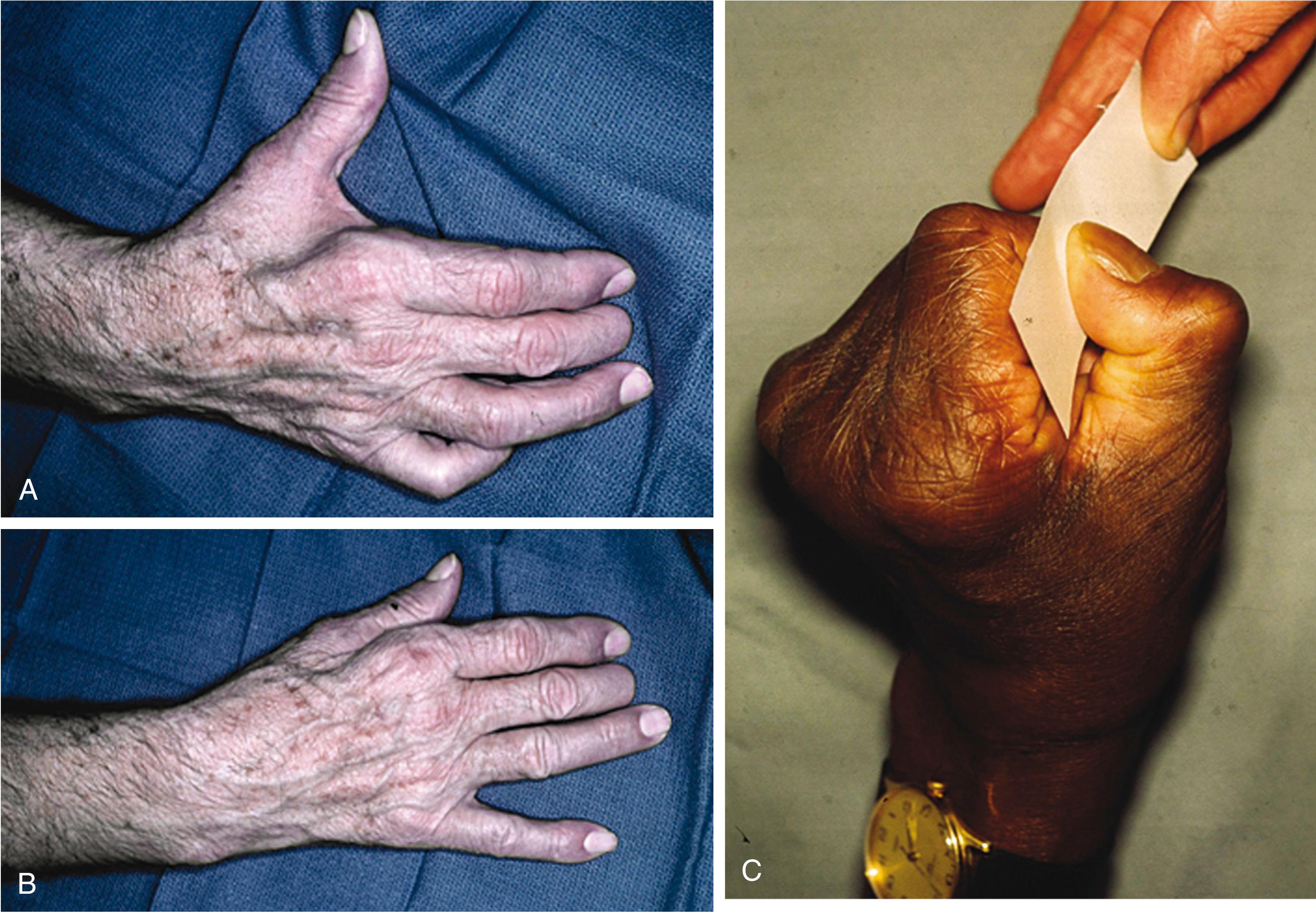
The Allen test confirms patency of the ulnar and radial arteries. Two-point sensory discrimination is the most sensitive method of testing for sensory loss and is easily done by using a bent paperclip ( Fig. 70.9 ). The paperclip ends are set to a distance of approximately 5 mm apart for fingertip pulp sensory testing. The points are aligned along the axis of the finger. If this test is not reproducible because of an uncooperative patient, suspicion of a nerve injury can be confirmed by the tactile adherence test in which a plastic pen is passed back and forth gently across the pulp on either side of each finger. Adhesion, because of the presence of sweat, is shown by slight but definite movement of the finger being examined (anesthetized finger pulp will not sweat).
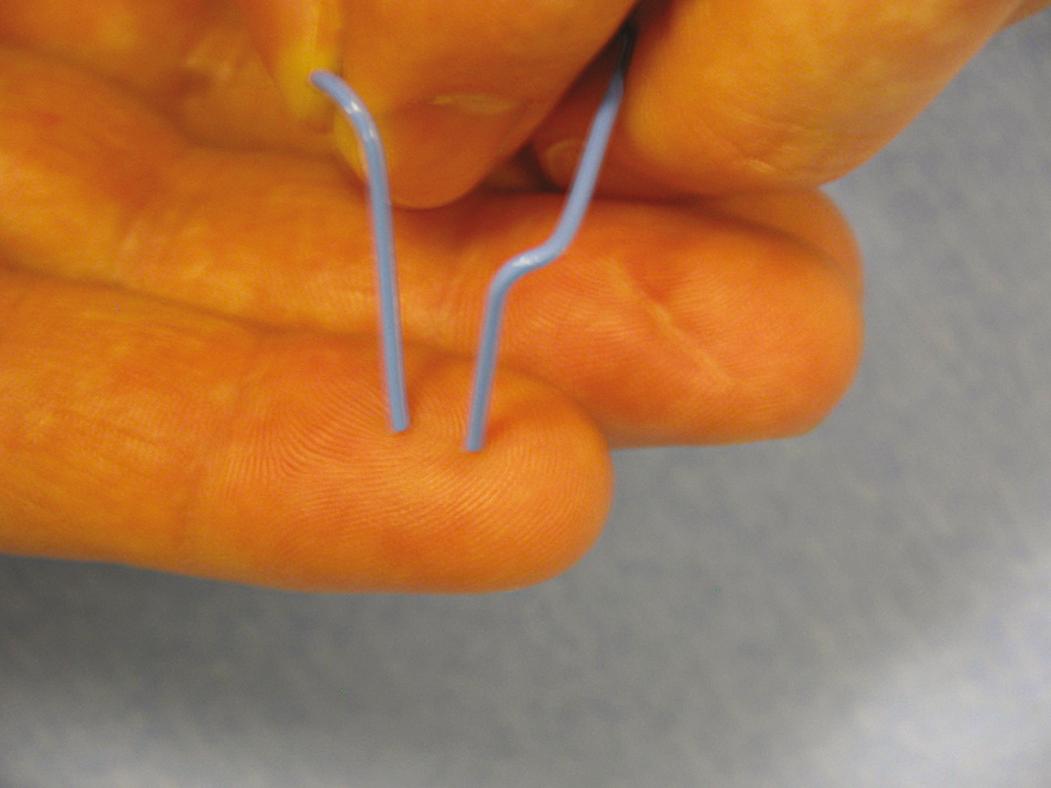
There are two muscle tests that may provide the examiner with an absolute diagnosis of median or ulnar nerve injury. The motor function of the abductor pollicis brevis tests the median nerve. With the hand flat and facing palm up, the patient is asked to use his or her thumb to touch the examiner’s finger, which is held directly over the thenar eminence ( Fig. 70.10 ). The flexor digiti minimi muscle function will test the motor supply of the ulnar nerve. In the same hand position, the patient raises her or his little finger vertically, flexing the MP joint to a 90-degree angle, with the IP joint held straight. Tests for function of the radial nerve and its branches require wrist extension, thumb extension, and finger extension at the MP joint.
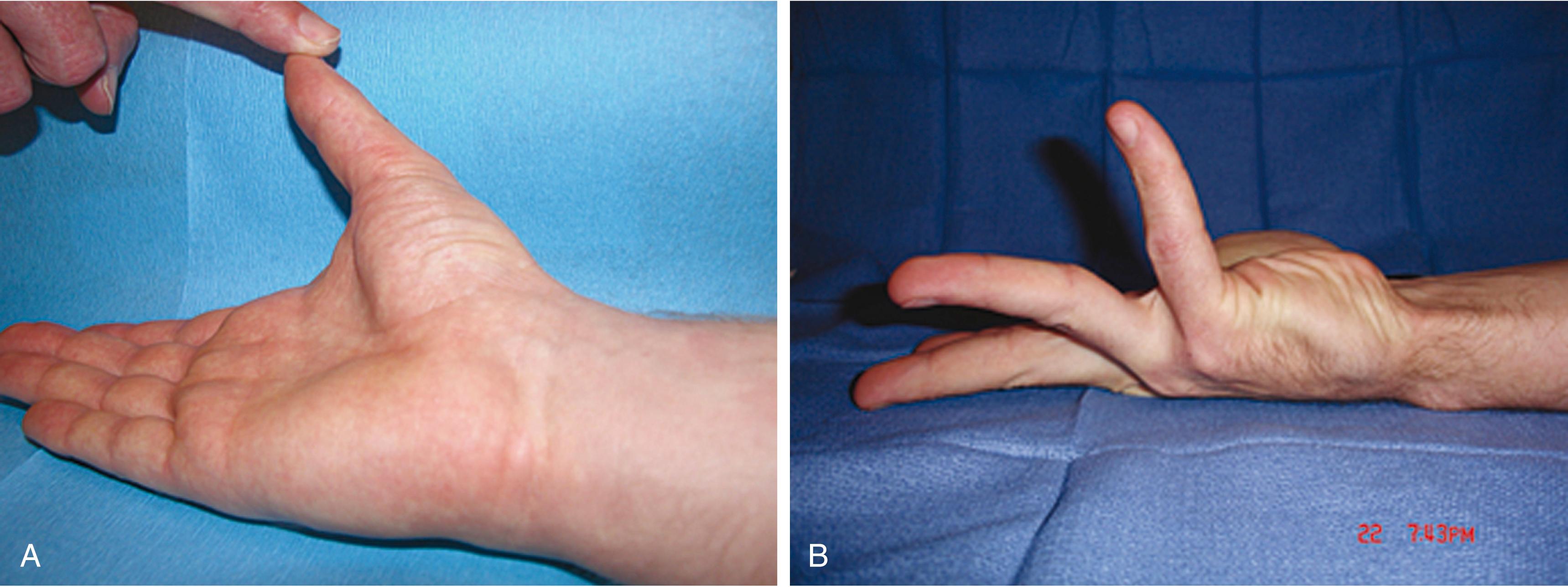
The integrity of the tendons is individually tested ( Fig. 70.11 ). Flexion at distal joints of the thumb and fingers confirms that the FPL and FDP, respectively, are intact. Testing of FDS tendons is more complex. It is not possible to flex the DIP joints independently of one another because of a common origin of the FDP tendons. Thus, the other fingers are fixed in extension by the examiner, and the patient is asked to flex the remaining digits. Movement is produced by the FDS and occurs at the PIP joint. In approximately one third of patients, the FDS cannot produce little finger flexion. In 50% of these, in turn, there is a common origin with the ring finger, so flexion will occur if the ring finger is permitted to flex simultaneously. More uncommonly, there is no profundus tendon to the little finger and the superficialis inserts into the middle and distal phalanges. The long and short extensors (EPL and EPB) and the long abductor of the thumb are tested by asking the patient to extend his or her thumb against resistance while these tendons are individually palpated. Long extensors of the fingers are tested by asking the patient to extend them against resistance applied to the dorsum of the proximal phalanx.
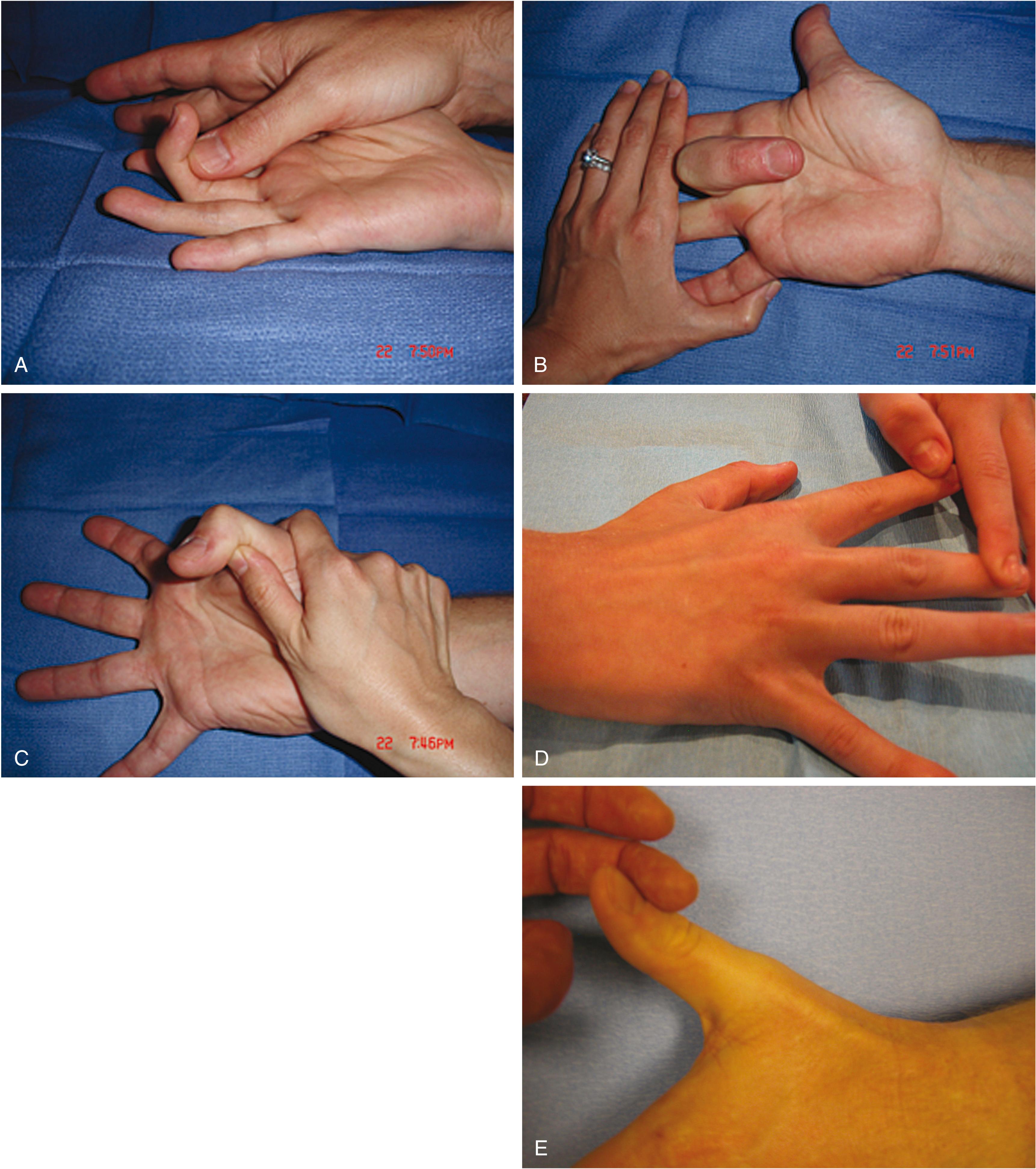
A closed boutonnière jamming injury may be difficult to initially diagnose. In this type of injury, the central slip insertion is disrupted from the middle phalanx and the triangular ligament on each side of the central slip is stretched or disrupted. The lateral bands then migrate volar. It takes time for this deformity to evolve. Initial presentation may not be immediately obvious until the lateral bands subluxate volarly and create the obvious boutonnière problem with PIP joint flexion and DIP joint hyperextension. The Elson test may help make this diagnosis. Normally, with the PIP joint blocked in flexion, one cannot actively extend the DIP joint because of slack in the lateral bands ( Fig. 70.12 ).
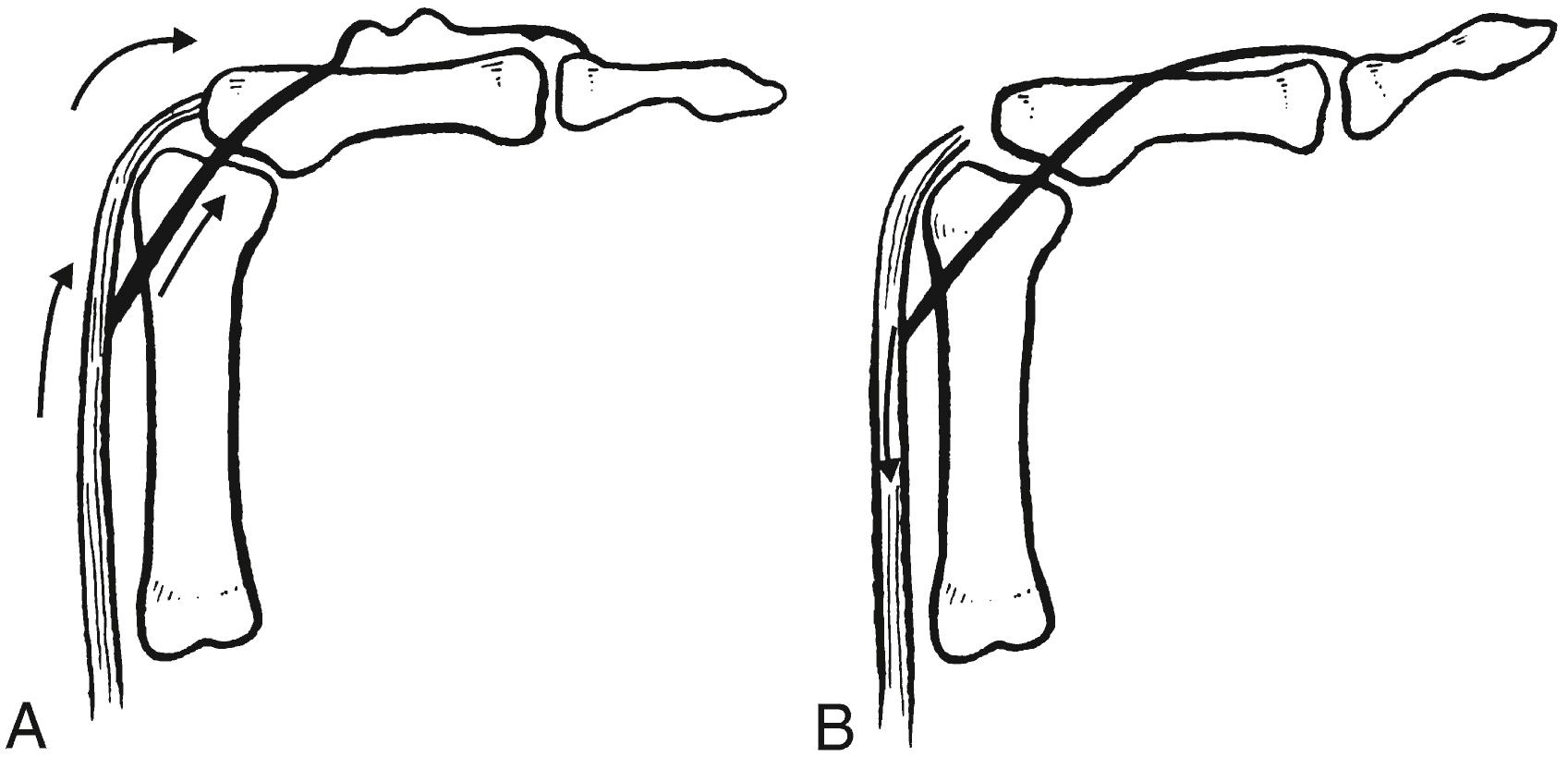
Radiographs are necessary in almost every case. These help in the diagnosis and evaluation of fractures and also in the investigation of foreign bodies. Multiple radiographic views of the affected part are required to define the precise pathologic process or fracture pattern. Glass is often seen on plain radiographs, and if it is not seen but suspected, it may be visualized by computed tomography (CT) or magnetic resonance imaging (MRI). If plastic is painted, it may be seen on routine radiographs; it is generally poorly visualized with CT but can be clearly seen with MRI. Wooden foreign bodies may be seen by CT or MRI but not by routine radiography.
Various stress radiographic views and cineradiography may be useful for demonstrating dynamic wrist instability patterns, especially scapholunate separation. Arthrography may detect ligamentous tears by extravasation of contrast material between the radiocarpal, distal radioulnar, and midcarpal joints. This is best combined with MRI, especially for the detection of triangular fibrocartilage tears at the ulnocarpal joint. Radionuclide bone scanning may help diagnose osteomyelitis, but in the hand, a false-positive result may occur because of the proximity of soft tissue infections to the bones. Occult wrist fractures may be localized by increased radionuclide uptake, but a false-positive result on evaluation for a fracture may also occur with ligamentous injuries. CT is a helpful modality for diagnosis of suspected carpal fractures (e.g., a scaphoid fracture that may not be seen on routine radiography), although most prefer MRI.
Wrist arthroscopy is useful as a diagnostic and therapeutic modality for a number of wrist problems, especially for disorders of the triangular fibrocartilage. Minimally invasive surgery with arthroscopic guidance has added a new dimension to the treatment of acute wrist disorders, such as scaphoid and distal radius intraarticular fractures.
Patients with ischemic problems often require noninvasive vascular studies. Doppler pressure measurements help localize the site of a vascular lesion. Angiography in the upper extremity is always carried out in the presence of a vasodilator (e.g., tolazoline [Priscoline], nitroglycerin) or an axillary block to differentiate apparent vessel occlusion from vasospasm. Subtraction radiographs with magnification help improve the detail and definition of the vascular study, especially in the distal forearm and hand.
In the case of injuries, treatment is directed at the specific structures damaged—skeletal, tendon, nerve, vessel, integument. , In emergency situations, the goals of treatment are to maintain or to restore distal circulation, to obtain a healed wound, to preserve motion, and to retain distal sensation. Stable skeletal architecture is established in the primary phase of care because skeletal stability is essential for effective motion and function of the extremity. This also reestablishes skeletal length, straightens deformities, and corrects the compression or kinking of nerves and vessels. Arteries are also repaired in the acute phase of treatment to maintain distal tissue viability. Extrinsic compression on arteries must also be released emergently, such as with compartment pressure problems. In clean-cut injuries, tendons can be repaired primarily. In situations in which there is a chance that tendon adhesions may form, such as when there are associated fractures, it is nonetheless better to repair tendons primarily with preservation of their length and to perform tenolysis, if necessary, at a later date. However, when there are open and contaminated wounds or a severe crushing injury, it is best to delay repair of tendon and nerve injuries.
In clean-cut sharp wounds, primary nerve repair lessens the possibility of nerve end retraction and therefore the need for later nerve grafting. However, primary nerve repair must not be performed in situations in which there is contusion of the nerve (e.g., gunshot wounds, power saw injuries, blunt crushing trauma) because the extent of proximal axonal injury may not be immediately evident. If nerve repair is performed before this is apparent, it may result in abnormal nerve ends being reattached, negating the chance for functional return.
In severe soft tissue injuries, wound closure may not be possible immediately. Initial open treatment of the wound is directed to prevent an infection and to protect critical deep structures by proper dressing and wound management ( Fig. 70.13 ). Adequate debridement is essential, but appropriate soft tissue coverage must be achieved as soon as possible thereafter. The sooner the soft tissue coverage can be achieved, the less likely there will be a secondary deformity caused by fibrosis and joint contractures. The more rapidly hand therapy can be started, the better the chance for maximizing functional return. The treatment regimen must consist of debridement, rigid skeletal fixation, and early soft tissue resurfacing, possibly even requiring microvascular soft tissue reconstruction, followed by protected range of motion exercises as soon as possible. It has been shown that early soft tissue reconstruction results in improved function, decreased morbidity, and shortened hospital stay.
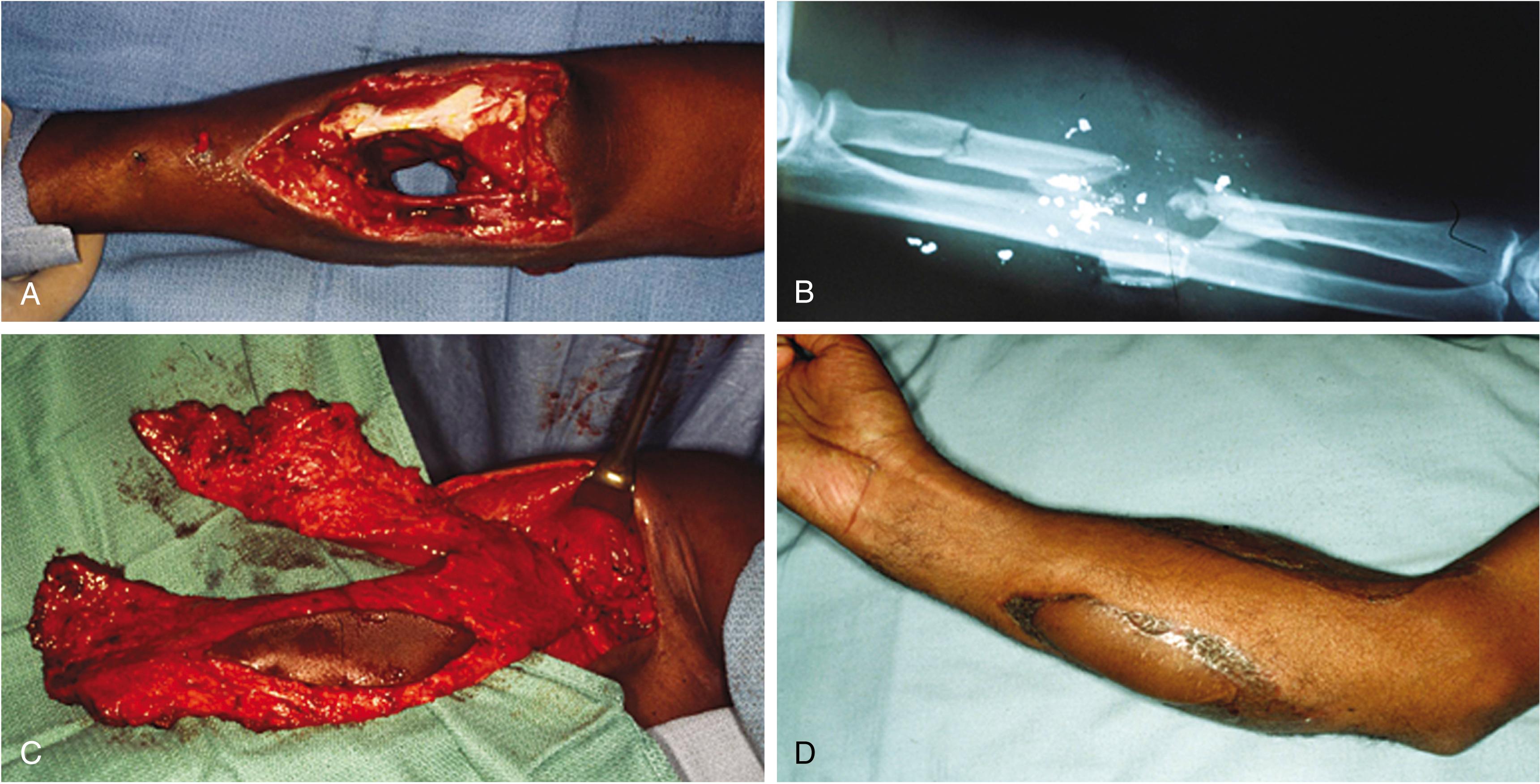
Appropriate treatment of upper extremity problems requires a thorough knowledge of local and regional anesthesia, use of a tourniquet to provide a bloodless field, correct placement of incisions to minimize later scar contracture, and appropriate use of dressings and splints to reduce edema and to maintain a functional position. Above all, a clear knowledge of the unique anatomy of the hand and upper extremity not only aids in obtaining an accurate clinical diagnosis but also enables the safe performance of surgery.
The choice of general, regional (e.g., intravenous Bier block, brachial plexus block that might be a supraclavicular or axillary block), or local anesthesia is governed by the extent and length of the operation. An upper arm or forearm tourniquet can be used in the unanesthetized extremity with only local anesthetic field infiltration or digital block for 30 to 45 minutes in a relaxed, cooperative patient, provided the arm is well exsanguinated. After this time, tourniquet pain will not permit more extensive local anesthetic procedures. If one has to operate in other areas, such as for harvesting of bone, nerve, tendon, or skin graft, or if more extensive surgical procedures are planned, general anesthesia will be required.
A digital block or median, ulnar, or radial wrist nerve block may be useful, especially for more limited emergency department procedures ( Fig. 70.14 ). Digital nerve blocks usually do not include epinephrine, which could lead to vasospasm, but evidence has indicated the safety of distal blocks using an epinephrine solution. A maximum safe dose of lidocaine is 4 mg/kg.
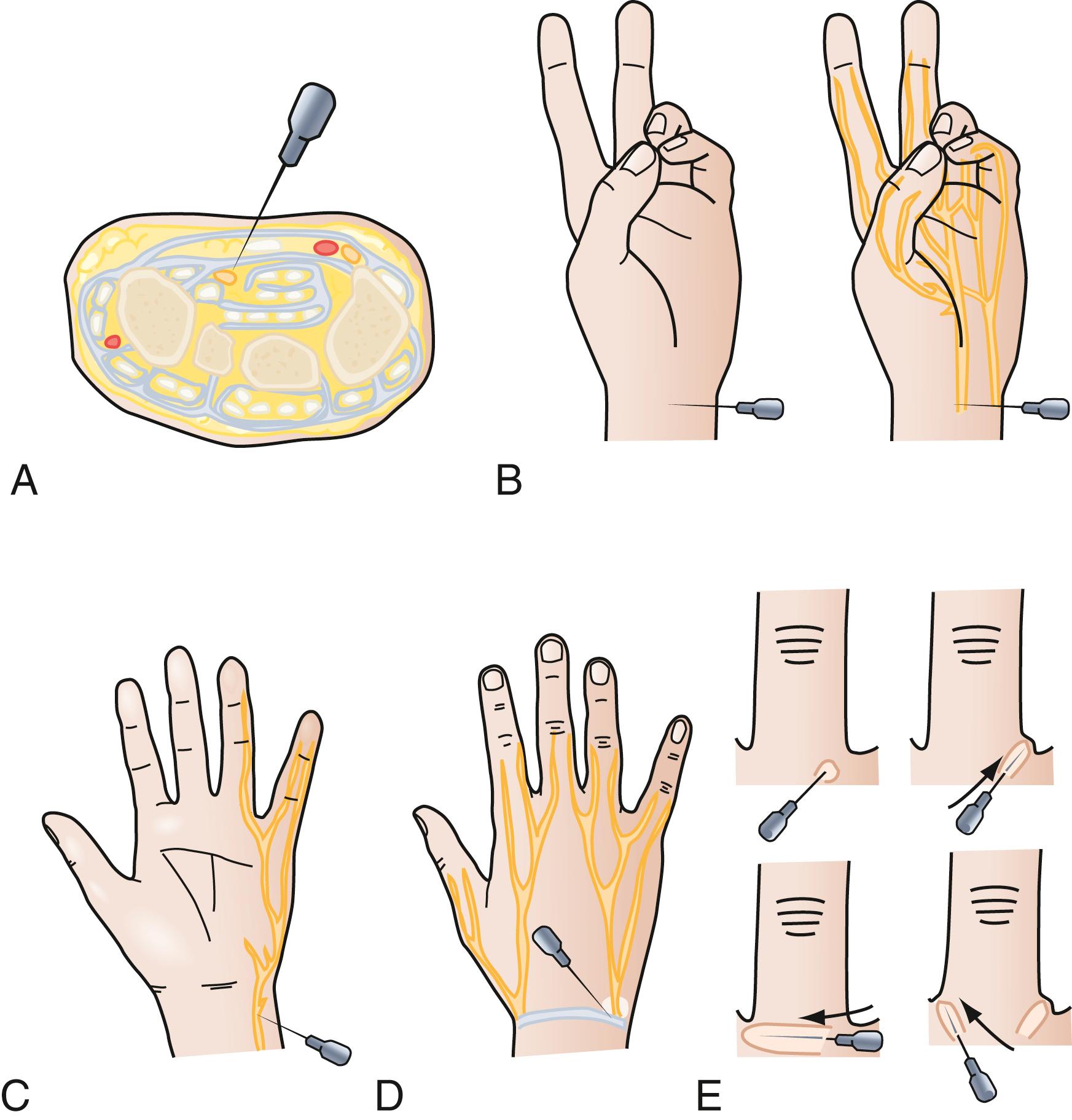
The tourniquet is used to provide a bloodless field so that clear visualization of all structures in the operative field is obtained. Penrose drains, rolled rubber glove fingers, or commercially available tourniquets can be used on digits. Great care must be taken when any constrictive device is used on digits because narrow bands cause direct injury to underlying nerves and digital vessels. With the use of an arm tourniquet, the skin beneath the cuff must be protected with several wraps of cast padding. During skin preparation, this area must be kept dry to prevent blistering of the skin under an inflated cuff over moist padding. The cuff selected needs to be as wide as the diameter of the arm. Standard pressures used are 100 to 150 mm Hg higher than systolic blood pressure. The cuff is deflated every 2 hours for 15 to 20 minutes (5 minutes of reperfusion for every 30 minutes of tourniquet time) to revascularize distal tissues and to relieve pressure on nerves locally before the cuff is reinflated for more extensive procedures. Exsanguination of the extremities is performed by wrapping the extremity with a Martin bandage in all cases, except those involving infection or tumors. In these latter cases, because of the possibility of embolization by mechanical pressure, exsanguination by bandage wrapping needs to be avoided. Simple elevation of the extremity for a few minutes before tourniquet inflation suffices.
Incisions are of the Bruner zigzag or midaxial type, or combinations of these, to avoid longitudinal motion-restricting scars that cross palmar flexion creases ( Fig. 70.15 ). The marginal edge of a skin graft with healthy skin is also a potential scar line, so the margin of the skin graft is designed to be in these same lines to prevent contractures across flexion creases. Palmar incisions follow the pattern of skin creases. Dorsal incisions on the fingers and wrist and incisions on the forearm may follow longitudinal straight lines.
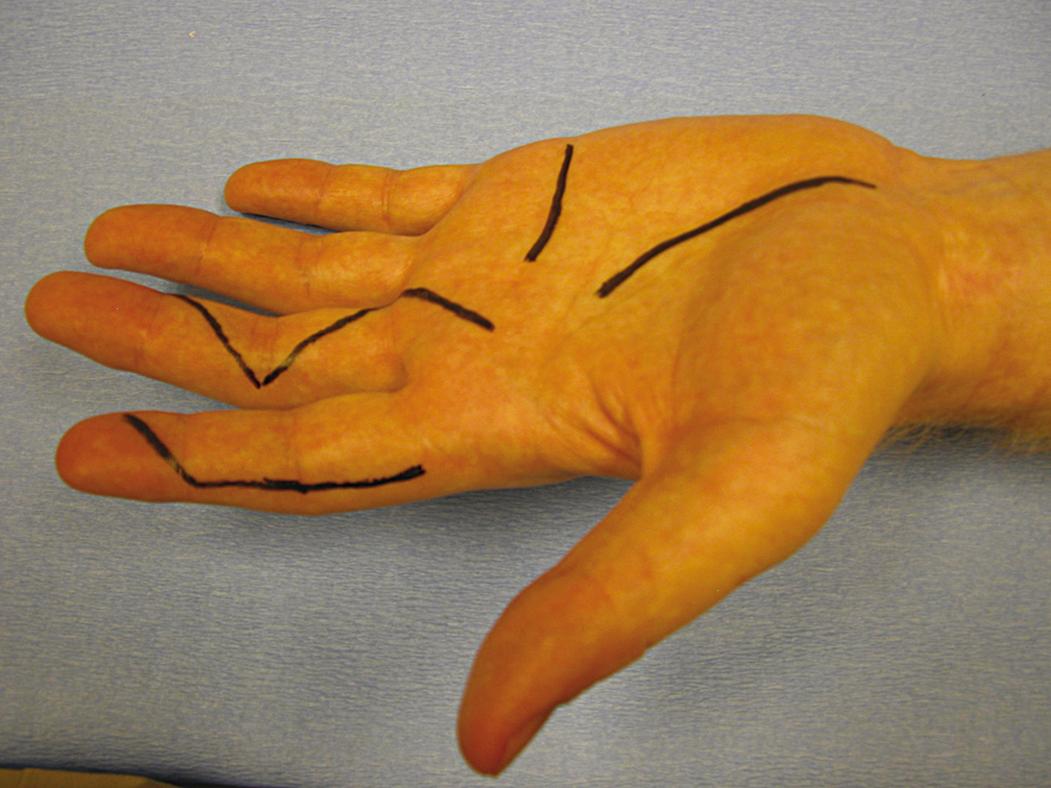
The purposes of dressings are to protect wounds, to absorb drainage, and to help splint repaired structures. The first layer consists of a nonadherent dressing and may contain an antibiotic. The next layer is soft and bulky and is usually followed by a firmer, more conforming external wrap. Conforming compression is useful, but constriction is harmful. Splints are made to protect only the part necessary to be immobilized and must not prevent motion in the remainder of the extremity. Often, patients keep the injured, operated, or infected hand in a flexed wrist position, which automatically causes the MP joints to extend, thereby placing the collateral ligaments in their shortest lengths. Edema fluid collects dorsally, and the resulting dorsal hand swelling causes stiff joints. Thus, a splint that keeps the hand in the protected position extends the wrist 40 to 50 degrees, maintaining the MP joints at 70 degrees of flexion and the IP joints in a neutral position ( Fig. 70.16 ). Postoperative hand elevation is essential to reduce edema.
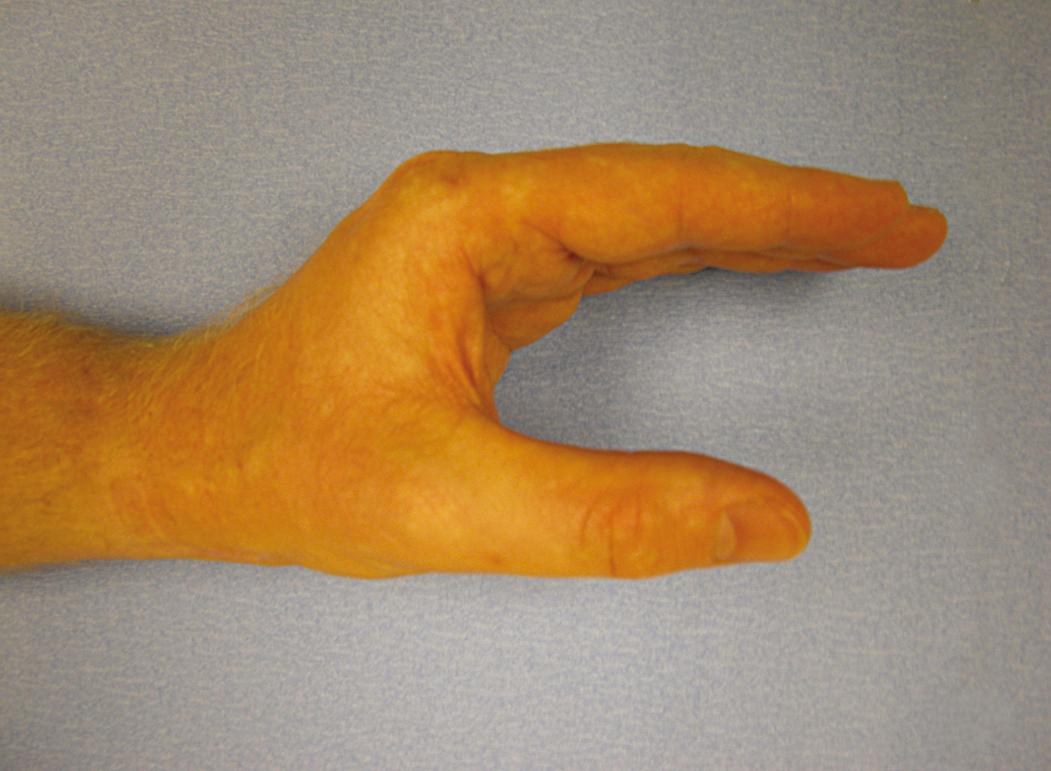
Bleeding in the extremity can often be profuse when it is first encountered. A reasoned and controlled assessment of the situation almost invariably results in the control of bleeding and minimization of further blood loss and facilitates necessary stabilization of the patient and appropriate assessment of the upper limb injury. Bleeding in the upper extremity often results when vessels lie in a superficial location, such as at the wrist. Bleeding can originate from superficial veins that bleed more profusely when poorly applied dressings result in venous engorgement. The thicker media of transected arterial walls contracts strongly, resulting in hemostasis. Partially lacerated arteries continue to bleed profusely.
If necessary, one may have no fear of using sympathomimetic medications and their potential vasoconstricting effect to support blood pressure, even if free flap reconstruction or microvascular repair has been done. A study evaluated four sympathomimetic medications and actually showed that both vasoconstricting and norepinephrine have a beneficial effect on flap skin blood flow, with the maximal beneficial improvement from norepinephrine. This is the optimal pressor to use in patients who may need blood pressure support after free flap surgery. Elevation and accurately placed point pressure over bleeding points result in hemostatic control in almost all cases. Brief use of tourniquets may be a useful adjunct to allow temporary control of blood loss in the emergency department. Poorly applied dressings may be removed, bleeding points identified, point pressure dressings applied, and the hand elevated. This should take no more than 5 to 10 minutes. Extended tourniquet application results in hyperemic bleeding on deflation and subsequently hinders the surgeon. Tourniquets should not be applied for any significant period of time before definitive repair in the operating room, except for control of torrential hemorrhage caused by major amputation in the field. Misguided attempts to control upper extremity bleeding with clamps, ligatures, and cauterization in the emergency department frequently result in additional avoidable injury to adjacent uninjured structures and to vessels that may need to be repaired for adequate limb perfusion. Fracture reduction and stabilization will improve distal perfusion and facilitate hemorrhage control by restoring the limb to its correct anatomic alignment.
Although it is tempting to look within a wound to determine whether any tendon or nerve injuries exist, the same information can be obtained by careful physical examination without further violating a potential operative field and causing the patient extreme discomfort. A combination of knowledge of anatomy, presence of sensory or motor deficits, and presence or absence of radial or ulnar pulses can narrow the differential diagnosis of injured structures to a minimum. Control of bleeding is attempted by direct pressure with dressings and not by blind clamping of vessels because vital structures may be inadvertently injured in the depths of the wound. However, a tourniquet may be used if the initial pressure measures fail. Tourniquets are generally not used initially because the entire limb will be ischemic during transport of the patient. If the trauma has caused complete obliteration of anatomy, incisions can be extended into nonviolated areas in which control of bleeding vessels and delineation of injured tendons and nerves may be easier, using the guidelines presented earlier for extremity incisions.
All patients who present with extremity injuries undergo radiography. Fractures of the distal phalanx are among the more commonly encountered hand fractures. A distal phalangeal fracture is appropriately splinted, reduced to improve alignment, or occasionally fixated internally if the fracture is unstable. Internal fixation is usually provided by simply placing a longitudinal 0.028-inch Kirschner wire. Appropriate antibiotics are administered because, technically, these are open fractures.
The least severe injury of the dorsum of the fingertip is a nail bed hematoma. When it is seen early, the hematoma can be decompressed by perforating the nail plate after the administration of a digital local anesthetic block. Fingertip and nail bed injuries can be managed with digital block anesthesia and a Penrose drain at the base of the finger as a tourniquet. After the nail plate has been stripped, simple gentle removal of the nail to examine the underlying nail bed is done, and suture repair of the nail bed is performed using loupe magnification and a 6-0 catgut suture. Once the nail bed has been repaired, it is best to place the thoroughly cleansed nail back under the nail fold, where it serves as a rigid splint for an underlying distal phalangeal fracture and prevents adhesions from forming between the adjacent surfaces of the nail fold, which might lead to an unsightly split nail deformity. If there is a piece of nail bed missing, the undersurface of the avulsed nail plate is examined. Frequently, the missing piece may still be adherent to the nail, and it can be gently removed and replaced as a nail bed graft. Some fingertip injuries may be so severe that amputation revision may be the most sensible and functional solution.
Volar fingertip injuries range from simple to more complex. Multiple digits may be involved, such as with lawnmower injuries. If bone is not exposed and a soft tissue defect of the finger pulp is smaller than 1 cm, the wound is best left open and managed with dressings. Such an injury will heal with excellent functional and cosmetic results. Larger soft tissue defects of the fingertip pulp are more appropriately treated with a small, full-thickness skin graft. However, if bone is exposed and the soft tissue wound is larger, flap coverage or revision of amputation by trimming back exposed bone to obtain soft tissue coverage should be considered. In a dorsally angulated fingertip amputation, soft tissue coverage can be achieved by a neurovascular V-Y advancement flap. If the soft tissue loss is angulated in a more volar direction, a cross-finger flap, adjacent finger digital island flap, or homodigital flap may be performed ( Figs. 70.17 to 70.19 ).
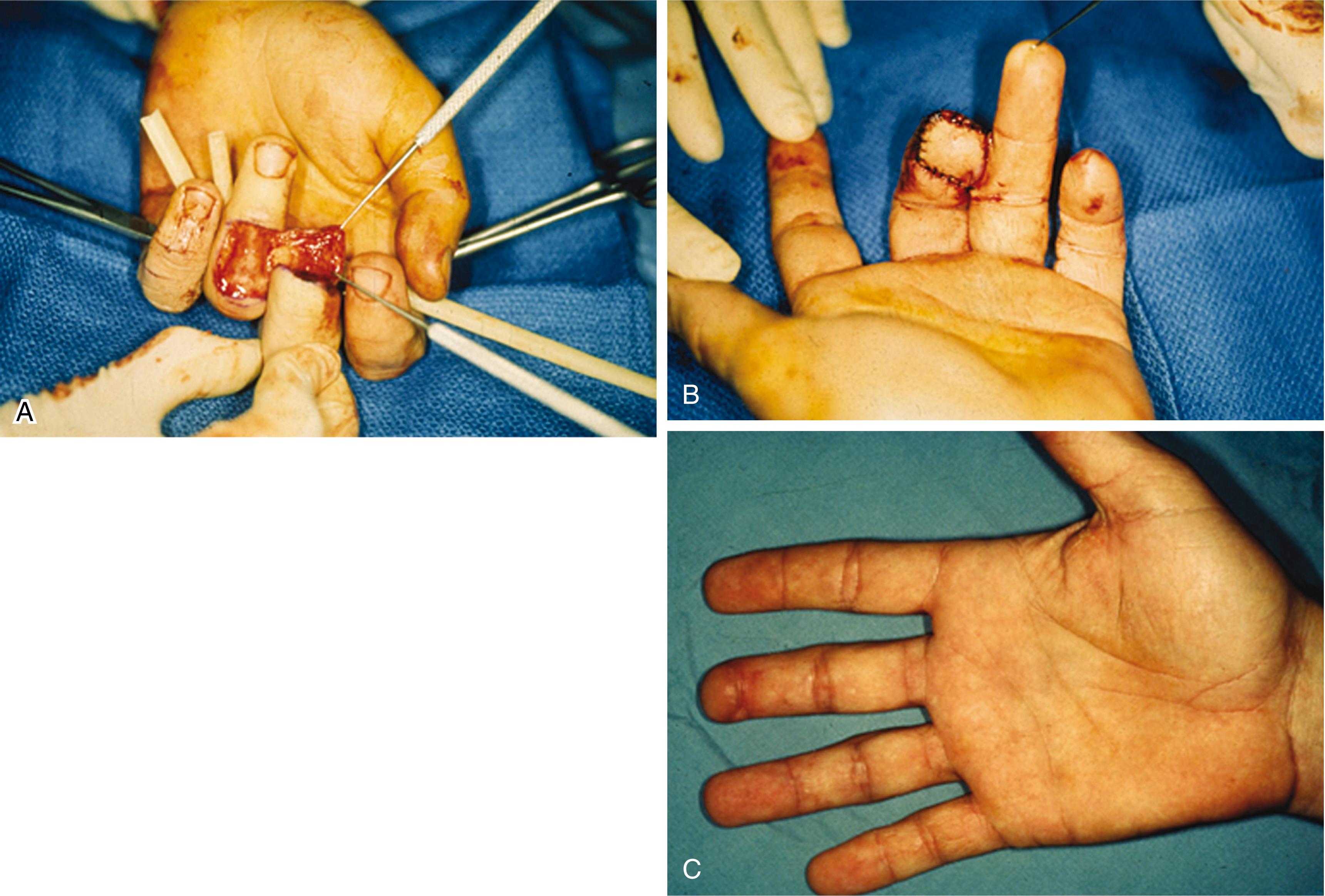
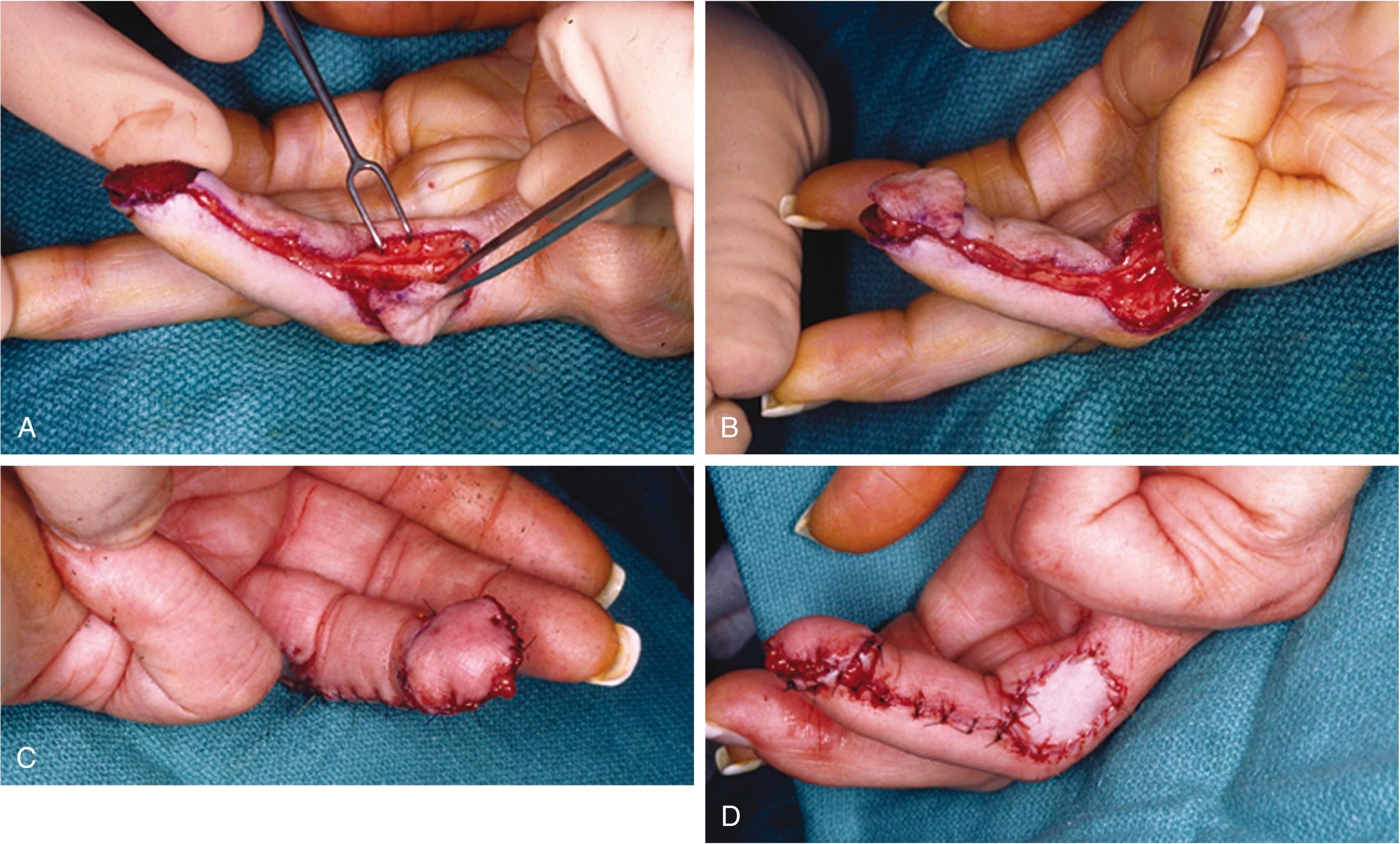

This algorithm for fingertip soft tissue coverage based on the geometry of the wound was previously time honored. However, with the larger homodigital flaps now available, that algorithm has changed because these flaps can be mobilized much more, are less restricted by their pedicle, and have a wider arc of rotation. For example, the retrograde homodigital island flap can pivot to cover either volar or dorsal fingertip wounds.
Flexor tendon injuries usually result from lacerations or puncture wounds on the palmar surface of the hand, although flexor tendons can be avulsed from their distal bone insertions by sudden violent contractions. These are best treated by a surgeon experienced in the treatment of such injuries. Flexor tendon injuries are divided into five zones ( Fig. 70.20 ). In zones 1, 2, and 4, each tendon is surrounded by a synovial sheath and contained within a semirigid fibro-osseous canal, either the flexor tendon sheath of the digit or the carpal tunnel. In the other zones, the flexor tendons are surrounded by loose areolar (paratenon) tissue. Those parts devoid of a fibrous sheath usually heal well because of the good blood supply from the paratenon. Tendons in the carpal tunnel (zone 4) have their rich blood supply provided by the mesotenon; however, zones 1 and 2 have a precarious blood supply through the vincula; complementary nutritional support is provided by the synovial fluid in these two zones. For tendon gliding to occur, the mesotenon has disappeared in the digital flexor sheath except at the sites of the vincula that carry the vessels from the periosteum to the tendons ( Fig. 70.21 ). Tendon zones to the thumb are T1 through T3.
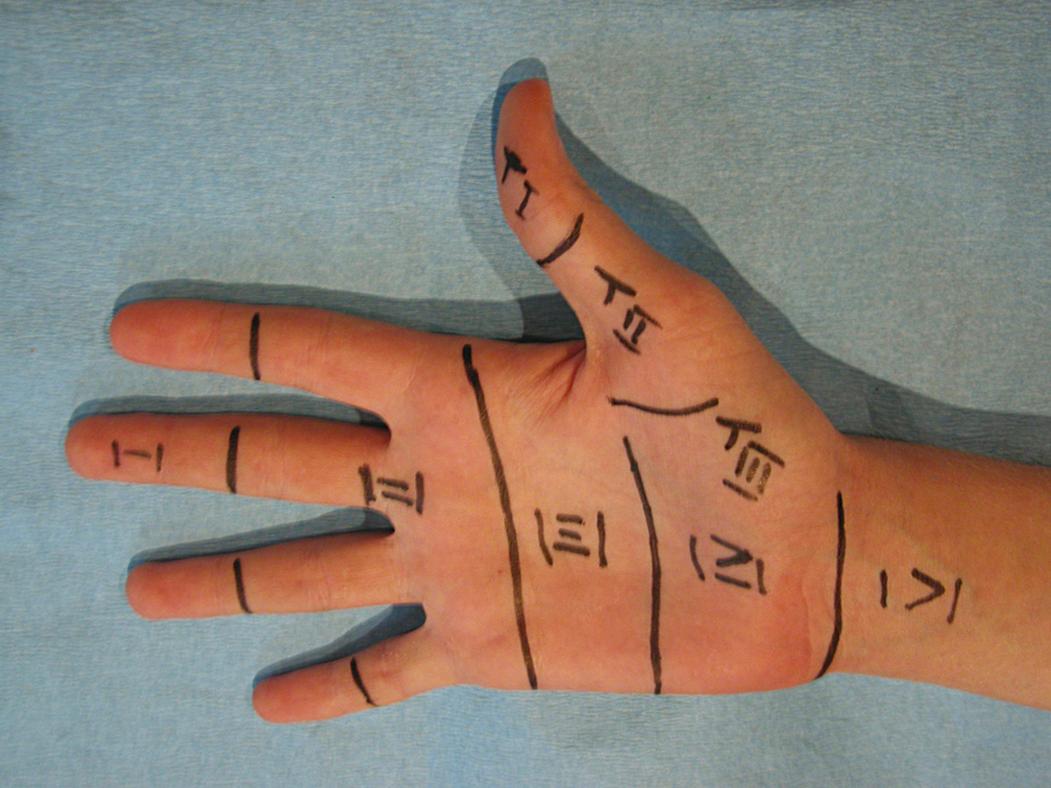
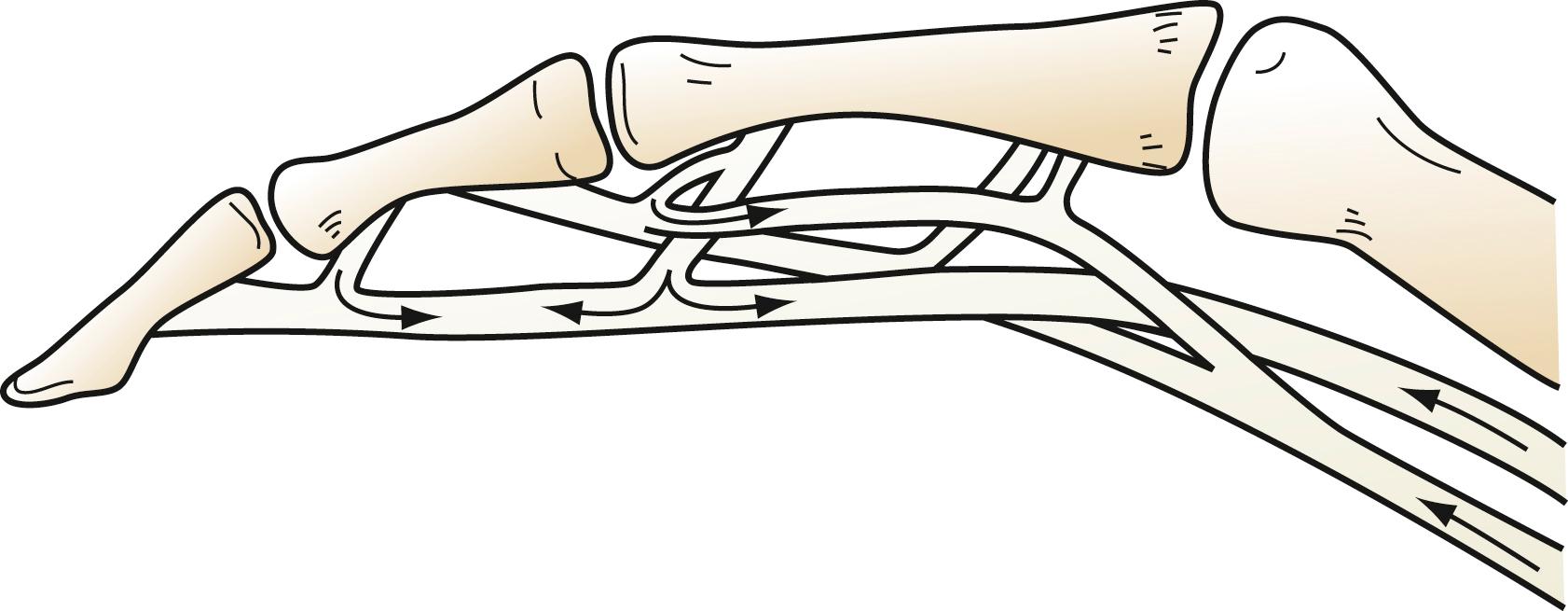
Primary tendon repair undertaken within a few hours of injury is generally reserved for cleanly cut tendons. Delayed primary repair is performed from several hours up to 10 days after injury and is indicated for tidy but potentially contaminated wounds to allow prophylaxis against infection before the tendon repair. Relative contraindications to immediate tendon repair include the following:
Injuries more than 12 hours old
Crush wounds with poor skin coverage
Contaminated wounds, especially human bites
Tendon loss of more than 1 cm
Injury at multiple sites along the tendon
Destruction of the pulley system.
After 4 weeks, a later secondary repair is generally not possible because of retraction of the musculotendinous unit so that reapproximation of the tendon ends produces undesirable joint flexion. In this situation, tendon graft repair may be required. The surgeon’s endeavors are directed at avoiding the four major complications that interfere with smooth gliding and the integrated action of tendons—adhesions, attenuation of the repair, repair rupture, and joint and soft tissue contractures. Prerequisites for tendon repair are aseptic conditions in the operating room with good lighting and good instruments, adequate anesthesia, and loupe magnification. A well-performed technical operation can be futile without proper postoperative hand therapy, splinting, and excellent compliance of the patient.
Appropriate treatment of partial flexor tendon injuries is necessary to produce a smooth juncture at the injury site. Prevention of complications requires exploration of all wounds likely to cause partial flexor tendon lacerations. A partial tendon injury of 50% or less is treated by simple trimming of the lacerated portion. Those injuries greater than 50% are repaired. Failure to diagnose a partial flexor tendon laceration at the time of primary repair may lead to delayed tendon rupture, entrapment between the tendon laceration and the laceration in the flexor sheath, or trigger finger.
Zone 2 flexor tendon injuries require special attention. This zone is also called Bunnell no man’s land. There are three tendons—the profundus and two slips of superficialis—that traverse zone 2, and they constantly interchange their mutual spatial relationships. Tendon injury in this region requires opening of the existing laceration in the flexor tendon sheath by making a longitudinal trap door so that a flap of tendon sheath can be elevated. Care must be taken to avoid excising excessive portions of the flexor tendon sheath because bowstringing may result in ineffective finger flexion, although portions can be vented or excised to facilitate repair or to prevent postoperative triggering. Total preservation of the A2 and A4 pulleys, previously thought to be essential, is no longer believed to be critical to success. One can excise up to 50% of the A2 and A4 pulleys without creating unnecessary tendon bowstringing if this is thought to be prudent to avoid the tendon repair’s impinging under the pulley. It has also been shown that one can incise the full length of the A4 pulley (but not excise it) without any biomechanical consequences. This is especially helpful when the zone 2 repair occurs proximate to the A4 pulley, the narrowest part of the flexor tendon sheath. Finally, wide-awake anesthesia, which is local anesthetic infiltration using a solution of lidocaine with epinephrine, enables flexor tendon repair without the use of a tourniquet and ensures full cooperation of the patient during the procedure. This was previously thought to be unwise, but this has been proved to be unsubstantiated. Thus, one can determine intraoperatively that there is full flexor tendon excursion at the repair site without impingement under the pulleys as the patient flexes and extends his or her fingers before the skin incision is finally closed. All these novel and revolutionary concepts challenge previously accepted dogma with regard to zone 2 flexor tendon repairs and the significance of the various annular pulleys. It is often difficult to repair profundus and superficialis tendons if they are injured in zone 2. Nonetheless, both can be repaired because resection of the superficialis reduces overall grip strength, predisposes to a recurvatum and swan neck deformity at the PIP joint, and damages the vincula supply to the profundus.
Skin wounds usually have to be extended proximally and distally in a zigzag fashion to display the retracted divided tendon ends. Tendon ends are handled with a fine-toothed forceps, and the tendon surface is never touched. The wrist is flexed, and a small Keith needle is passed transversely through the proximal tendon, approximately 2 cm from the end, transfixing it to the skin and tendon sheath. In this way, immobilization of the tendon end facilitates a tension-free repair. Ragged tendon ends may be squared off sharply, but no more than 1 cm is resected or permanent finger contracture will result. The tendon ends are brought together by a single tension-holding, locking, core suture. Various locking core suture techniques have been described, but a modified Kessler-type suture is usually placed. A specifically placed locking loop increases the ultimate tensile strength of the tendon repair by 10% to 50% compared with a simple mattress suture. If this is not done, tension on the suture line can open up the repair, increasing the propensity for tendon gapping at the repair site. The ideal suture material for tendon repairs has not been found. In a study comparing a six-strand flexor tendon repair, braided polyblend (FiberWire) fared best compared with braided cable nylon (Supramid Extra II) and braided polyester (Tendo Loop) for both ultimate tensile strength and gap force. Tendon repair gapping is important because the exposed tendon ends, although not disrupted totally, lead to increased adhesion formation. However, the knot security of FiberWire remains a concern, requiring at least five-throw knots to minimize unraveling. Thus, FiberWire is generally not used for repair of tendons within the flexor tendon sheath because of the necessary bulkiness of the knots.
A 4-0 coated polyester or braided nylon suture is the best material for the core suture. Increasing the number of suture strands that cross the tendon repair site and obtaining suture bites of at least 0.7 cm will increase the overall tensile strength of the actual repair. However, the more suture strands that are added, the greater will be the friction and edema within the flexor tendon sheath. A four or six-strand core repair appears to provide optimum repair strength and does not increase stiffness and friction at the repair site excessively. Some perform a four-strand core repair by simply using a double-strand type of suture material, whereas others place a second core suture with a single-strand material. A four-strand core repair permits a light, protected, composite grip for the duration of postoperative healing. A running circumferential epitenon suture repair is also placed ( Fig. 70.22 ). This not only helps smooth the repair but also adds to the ultimate tensile strength at the repair site and reduces gap formation. A peripheral 6-0 nylon suture serves this purpose.
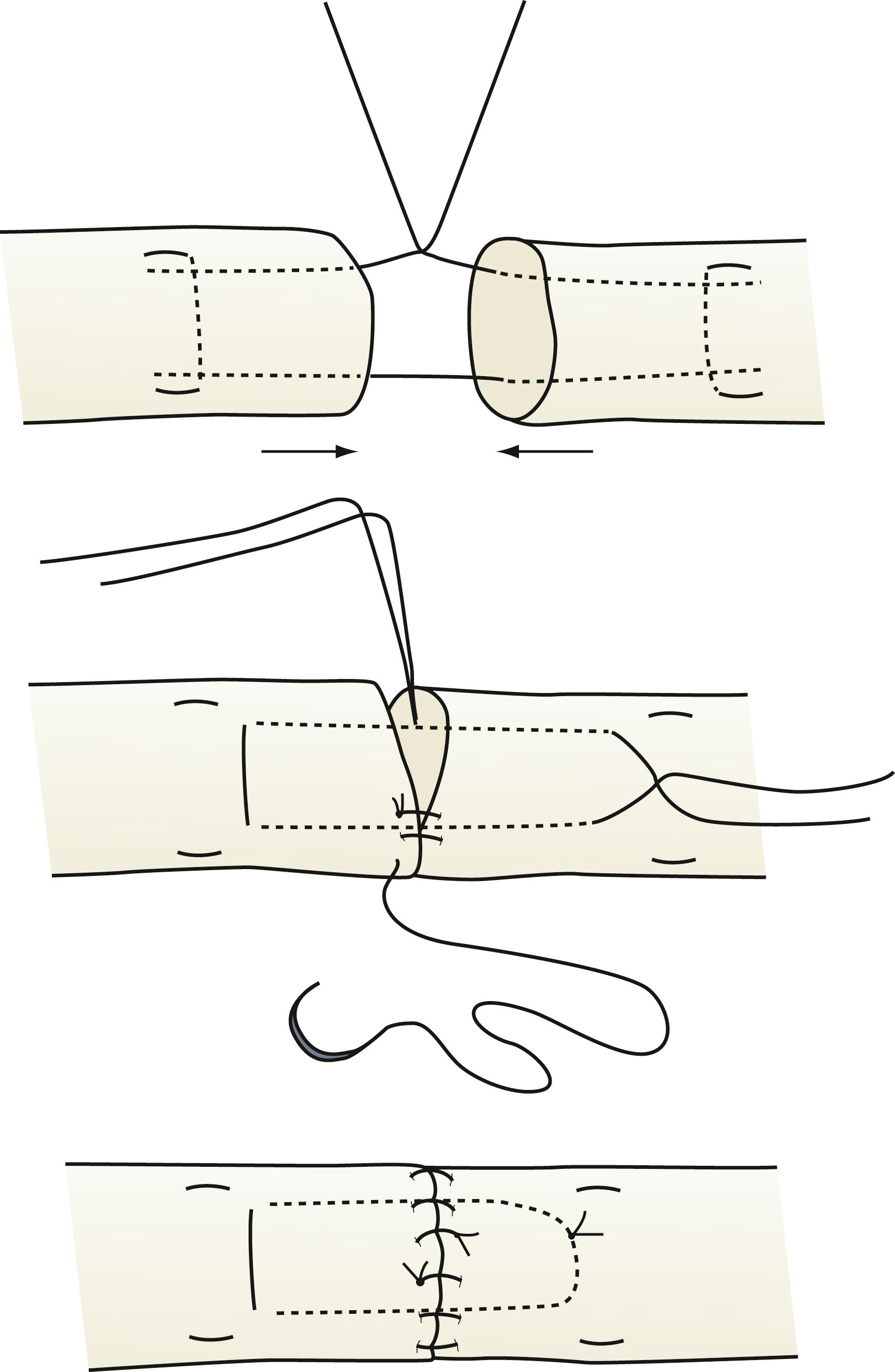
The forces generated on FDP flexor tendons are 600 g during passive finger flexion and 2000 g during active finger flexion; with strong active finger flexion, they are 8000 g. However, after tendon repair, the effects of wound healing, changes in elasticity, and added friction between the flexor tendons and their surrounding tissues will affect the overall work of flexion. There will be added frictional forces caused by edema, the presence of suture material, and the pulley system. The estimated work of flexion (resistance) increases by a factor of 50% after tendon repair. Thus, the estimated forces on repaired tendons, with 50% added for the work of flexion, are 900 g for passive finger flexion, 3000 g for active finger flexion, and 12,000 g for strong active flexion. The ultimate tensile strengths of various repairs are 2600 g for two-strand and simple epitendinous repair, 4600 g for four-strand and simple epitendinous repair, and 6800 g for six-strand and simple epitendinous repair. The strength of the initial tendon repair decreases by approximately 25% during the first 3 weeks and then steadily increases thereafter to 6 weeks. Hence, if one is to undertake a postoperative active finger flexion protocol, at least a four- or six-strand core suture tendon repair is needed.
A variety of interventions have a potential of enhancing tendon repair and healing. Active tendon motion protocols tend to attenuate the weakening of repair strength that we used to believe was an obligatory part of normal tendon repair site healing in the first 3 weeks. In addition, therapy with stem cells can enhance strength of tendon repair because of their regenerative potential. Mechanical stimulation of active motion protocols may potentially act in this by stimulating stem cells. Zone 1 flexor tendon injury may be caused by a penetrating injury. However, closed traction injury may also cause profundus tendon avulsion, which most frequently involves the ring or middle finger. In the repair of a zone 1 injury, a pullout suture is necessary if the distal tendon length is insufficient to repair the tendon securely ( Fig. 70.23 ), although suture bone anchors have facilitated this mode of tendon repair into bone at the base of the distal phalanx.
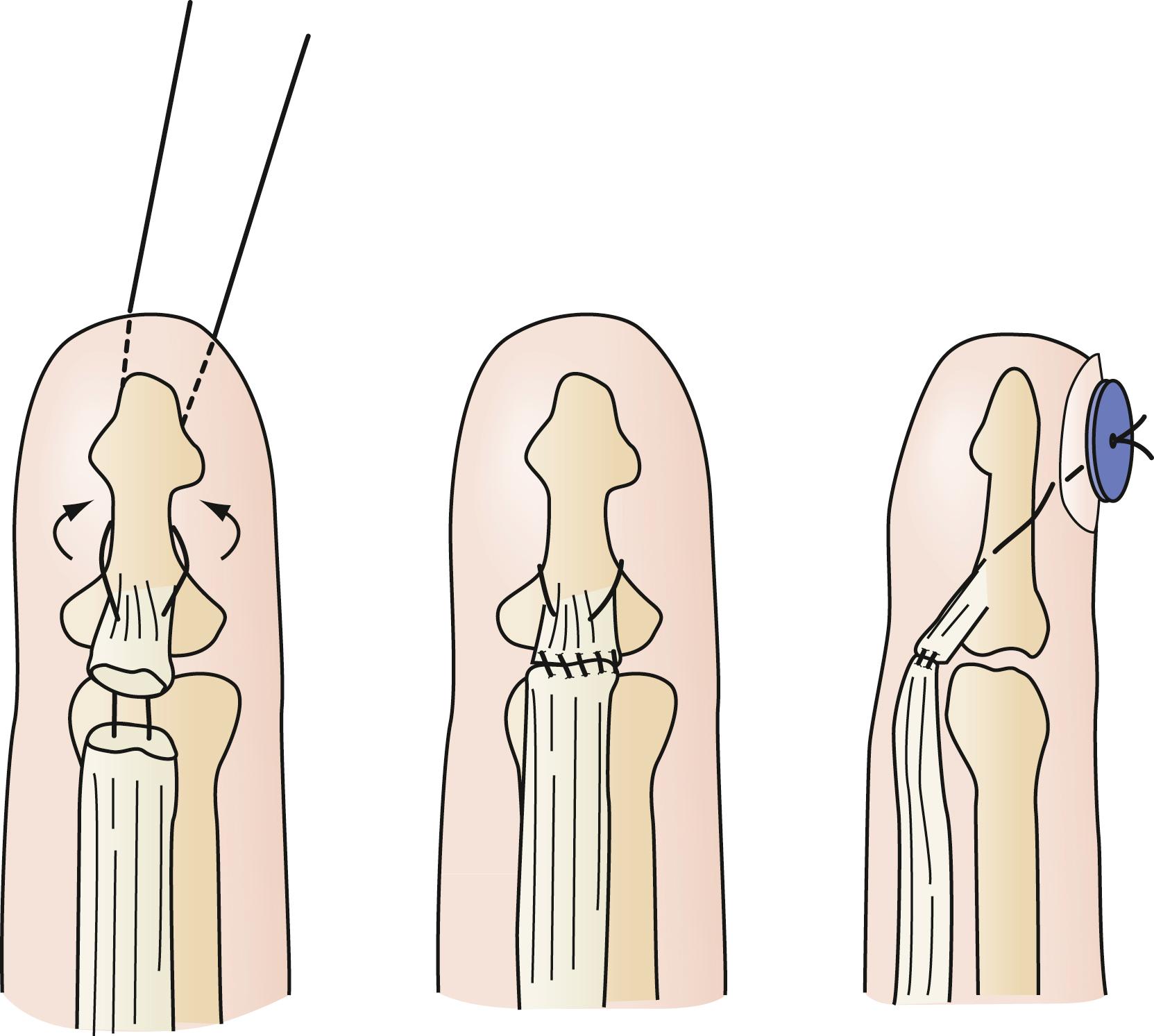
Postoperatively, hand elevation is important to reduce edema. The wrist is placed in approximately 20 degrees of flexion and the MP joint at approximately 60 to 70 degrees of flexion. The splint is molded against the fingers, with the IP joints fully extended. A system of rubber band dynamic traction may be used after the repair of flexor tendons in zone 2, with good results obtained in more than 80% of cases. Differential excursion between the two digital flexors is dramatically increased by a synergistic splint that allows wrist extension and finger flexion. This position of wrist extension and MP joint flexion produces the least tension on a repaired flexor tendon during active digital flexion; thus, we have come to use the flexor hinge brace technique and the so-called place-and-hold protocol ( Fig. 70.24 ). Of all the postoperative flexor tendon protocols, this enables the greatest overall tendon excursion of each of the FDS and FDP tendons and the most significant differential tendon gliding between the FDS and FDP repair sites, which theoretically would then reduce the risk of adhesion formation between the two tendons. A tenodesis brace with a wrist hinge is fabricated to allow full wrist flexion, wrist extension of 30 degrees, and maintenance of MP joint flexion of at least 60 degrees. After composite passive digital flexion, the wrist is extended and passive finger flexion is maintained. The patient actively maintains digital flexion and holds that position for approximately 5 seconds. The patient is instructed to use the lightest muscle power necessary to maintain digital flexion. Wrist flexion and finger extension follow. This protected motion postoperative protocol is continued for 6 weeks.
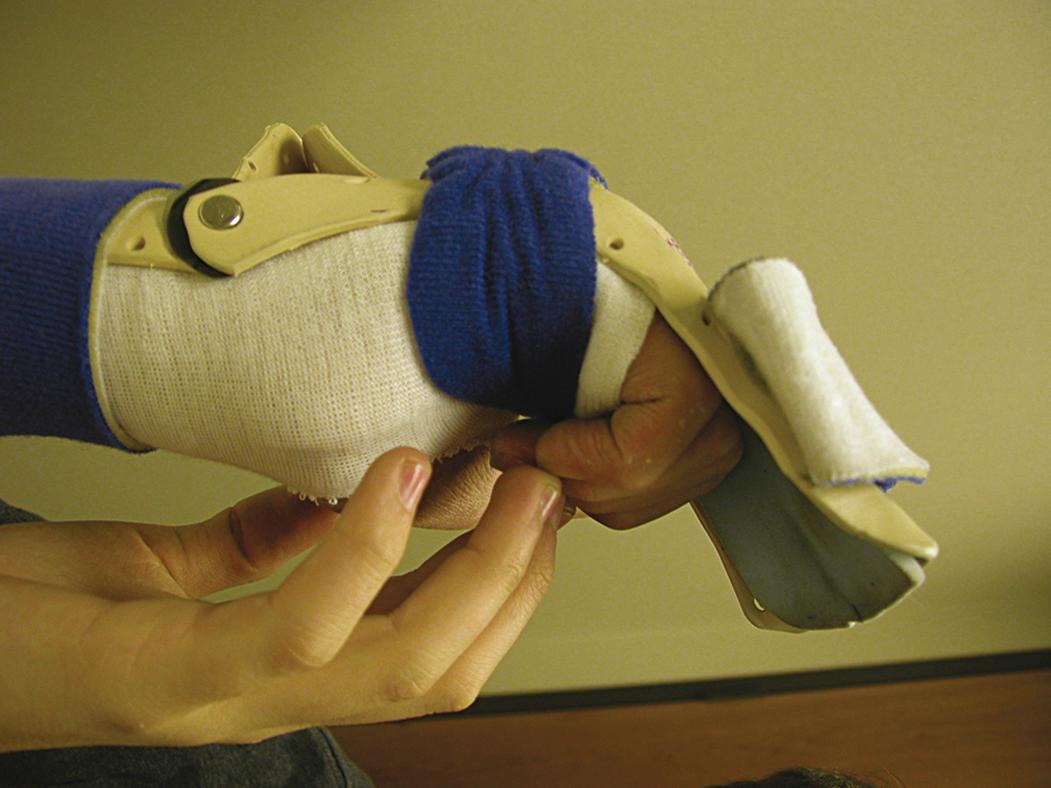
Proper diagnosis of extensor tendon injuries requires full knowledge of the relatively complex anatomy of the extensor mechanism of the dorsum of the finger. The subcutaneous location of extensor tendons makes them susceptible to crush, laceration, and avulsion injuries. The presence of juncturae tendinum prevents proximal retraction of the EDC tendons. Extensor tendon injuries have been divided into nine zones, which ascend numerically from the dorsum of the DIP joints to the forearm. The odd-numbered zones begin at the DIP joint and are located over the joints; the even-numbered zones are located between the joints.
Extensor tendons are thinner than flexor tendons and, over the dorsum of the digits, are spread out to form the extensor hood. It may occasionally be possible to use conventional tendon repair techniques in the proximal parts of the tendons, but this is usually not the case in the extensor hood region. Here, horizontal mattress sutures or figure-of-eight mattress sutures may be needed. All lacerations are repaired if 50% or more of the tendon is divided.
Extensor tendon avulsions are most likely to occur at the DIP joint from a jamming type of injury that results in a mallet finger deformity ( Fig. 70.25 ). If a bone fragment representing 50% or more of the articular surface is involved or if there is volar subluxation of the DIP joint, an open reduction with internal fixation is performed. If there is a tendon rupture only or a small piece of bone is avulsed with the tendon, good results can be obtained by 6 weeks of continuous splinting with the DIP joint in extension ( Fig. 70.26 ). After this period of splinting, the DIP joint is further protected during sleep for 2 more weeks.
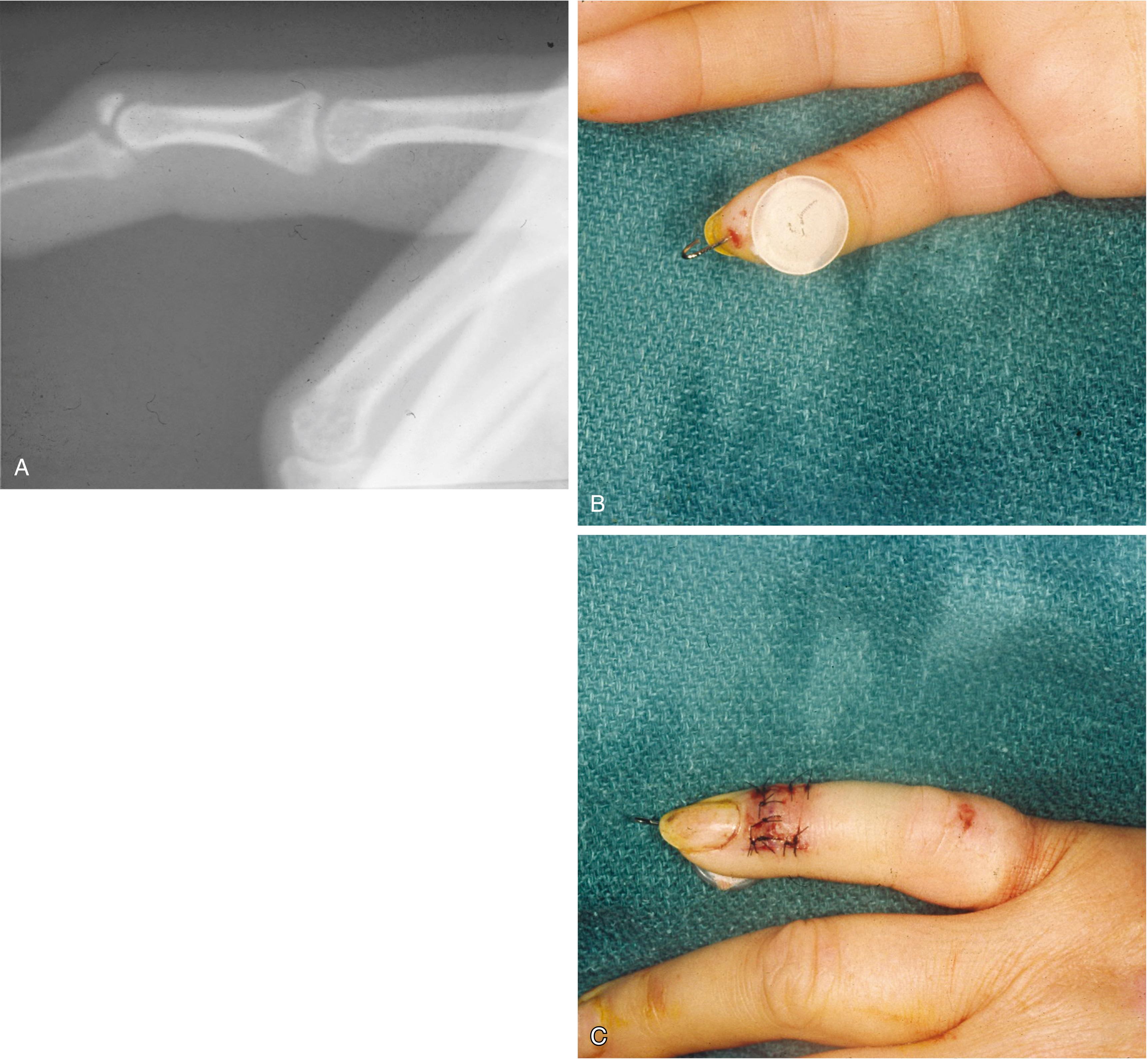
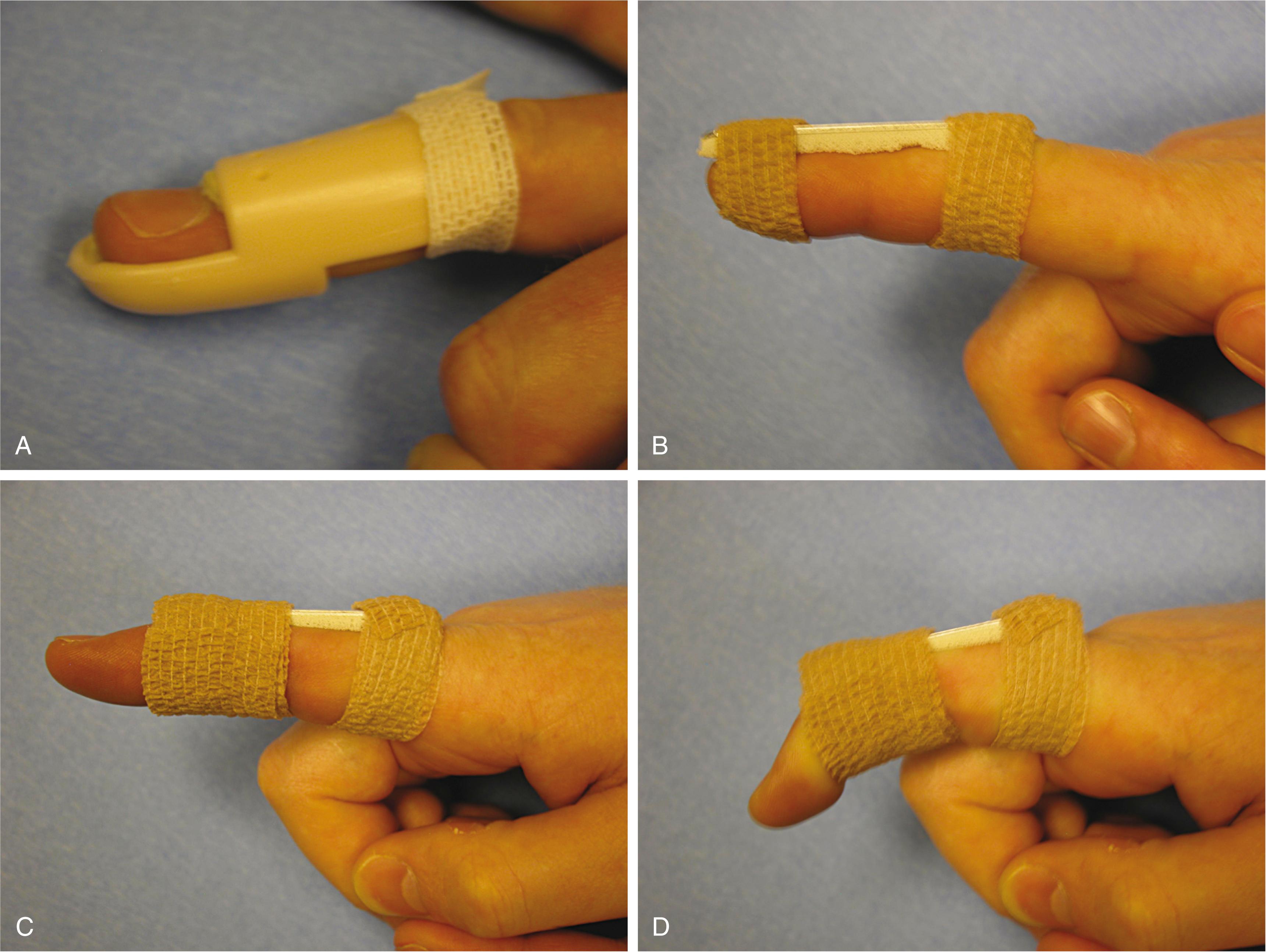
Closed tears through the triangular ligament may be caused by PIP joint subluxation or a jamming type of injury that results in a boutonnière deformity. The central slip attachment at the base of the middle phalanx is disrupted so that extension of that joint is altered. The lateral bands lose their support dorsal to the PIP joint axis and slip volar and become flexors at the PIP joint and extensors of the DIP joint. The consequent deformity is one of flexion at the PIP joint and hyperextension at the DIP joint. Within 6 weeks of injury, these can be treated satisfactorily by extension splinting at the PIP joint, maintaining the DIP joint free for active flexion and extension ( Fig. 70.26 ).
A recently described novel way of splinting and treating closed boutonnière injuries of the finger is to use the relative motion splint shown in Fig. 70.27 but to have the proximal phalanx of the injured digit blocked from fully extending. This has been shown to realign the lateral bands dorsally over the PIP joint.
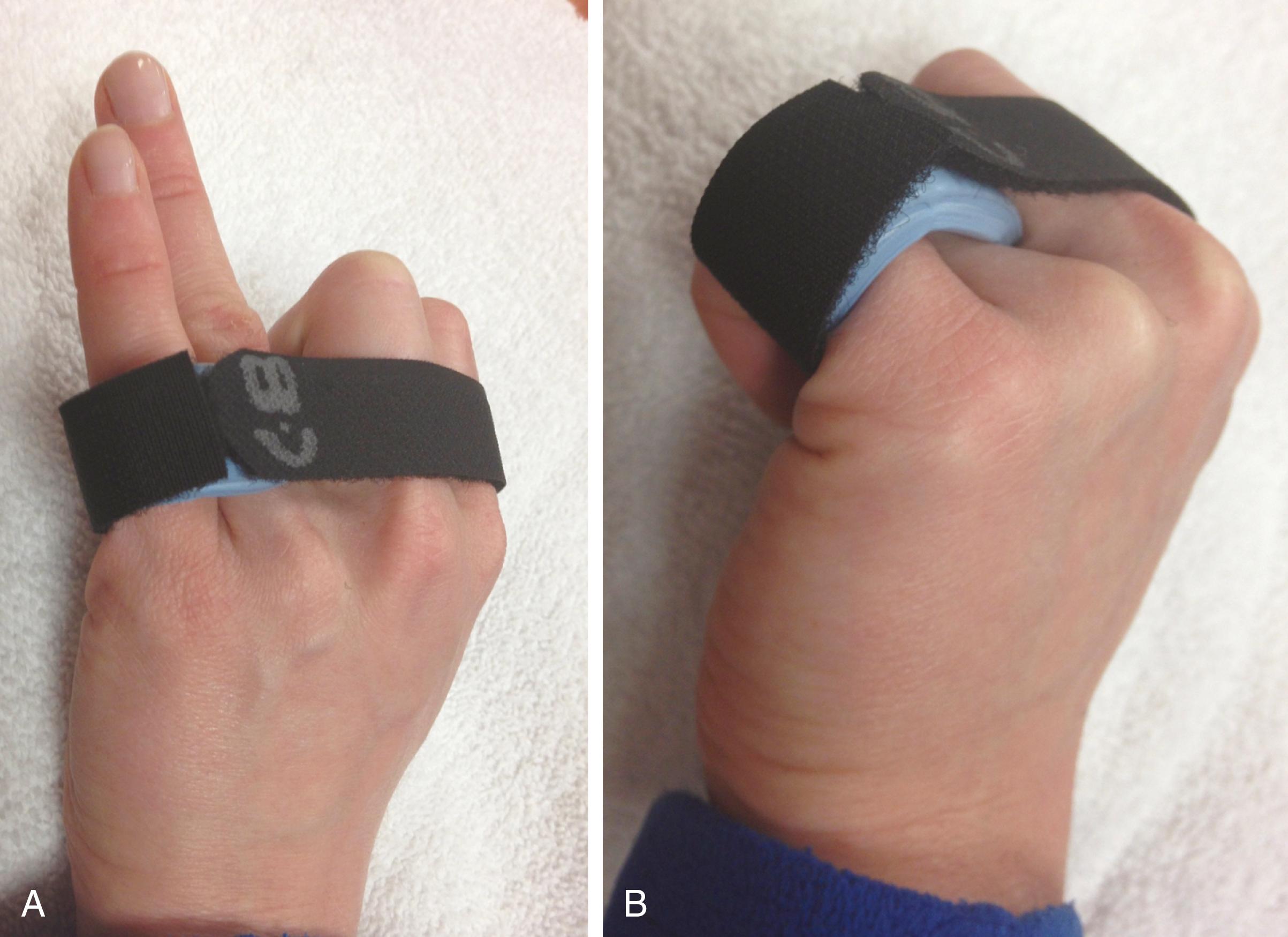
If there is an open laceration to the central slip mechanism and adjacent triangular ligament, direct suture repair or reinsertion into bone by means of bone anchor minisutures is performed, followed by the same postoperative protocol.
Extensor tendon injuries proximal to the PIP joint result in a drop finger ( Fig. 70.28 ). These are repaired and splinted for 4 weeks. Common extensor tendon injuries over the dorsum of the hand and at the wrist must be repaired and then treated postoperatively by various different controlled motion protocols. One is a dynamic rubber band extension outrigger brace or use of a relative motion splint in which the affected digit is kept at a more dorsal pitch to the adjacent fingers, thus relaxing the repaired tendon. The relative motion splint causes minimal interference with daily activities during rehabilitation ( Fig. 70.29 ).
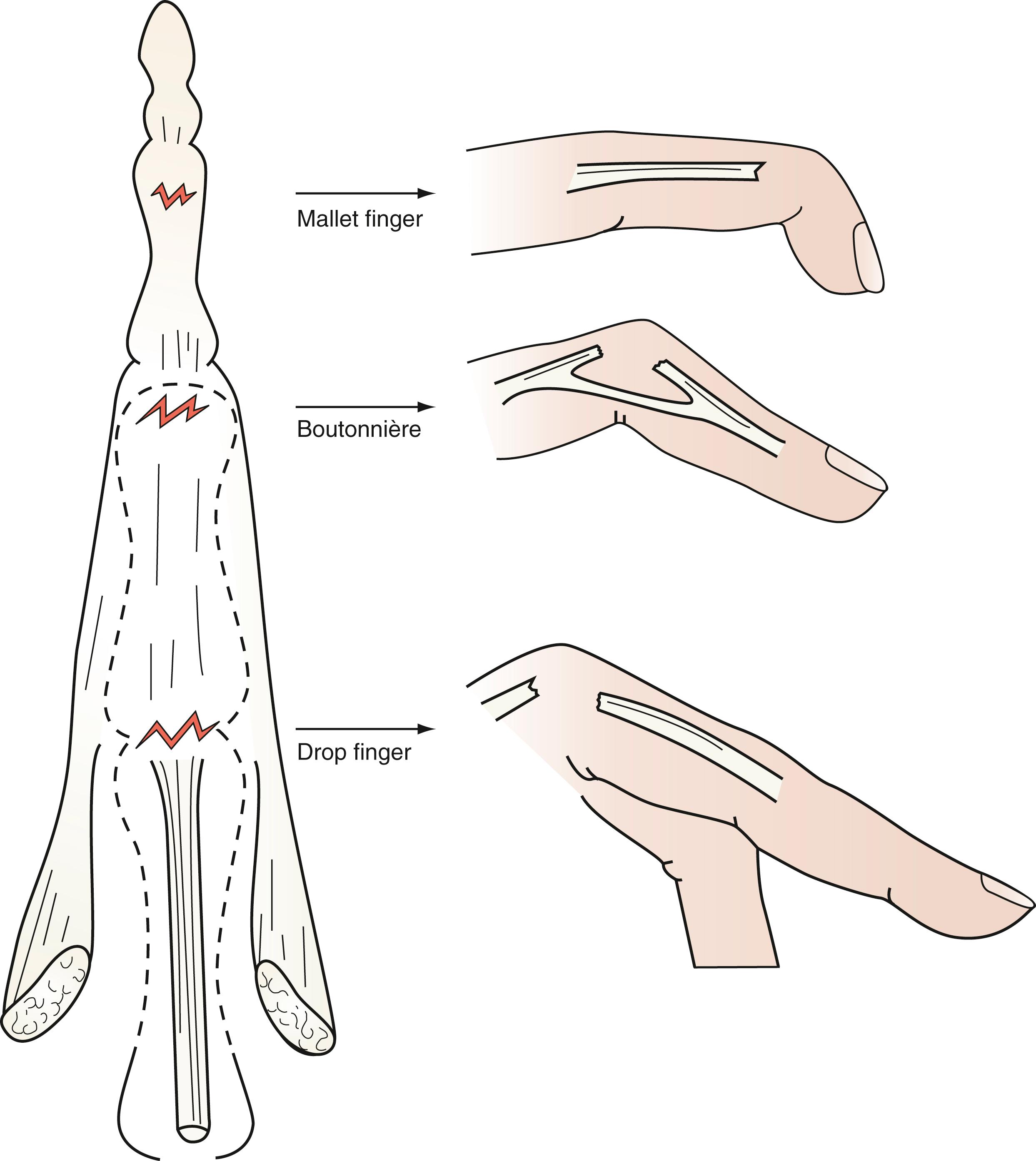

Sunderland classification, the most widely used classification, describes five types of nerve injury: neurapraxia (grade I), axonotmesis (grades II to IV), and neurotmesis (grade V). Neuropraxia is a physiologic block of impulse conduction without anatomic destruction of nerve fibers. This might occur with a closed injury, such as a radial nerve injury in the spiral groove associated with a midshaft humerus fracture. Neurapraxia may occur because of prolonged pressure in a tight anatomic location (e.g., carpal tunnel) or prolonged application of a tourniquet. Provided the offending cause is promptly removed, spontaneous recovery is generally the rule but can take as long as 3 months. In axonotmesis, axonal fibers are completely ruptured, generally from traction on the nerve (II). With higher energy injuries, the endoneurial (III) and perineurial (IV) nerve sheaths that support and nourish the axons and fascicles are progressively injured, leading to poorer nerve recovery with increasing damage to intraneural architecture. Neurotmesis refers to complete transection of a nerve and is the most severe degree of nerve injury. It may result from direct sharp trauma or a violent traction injury. Accurate approximation of the cut nerve ends and meticulous repair are required for the best possible recovery. Axonal regeneration after axonotmesis or successful nerve repair after neurotmesis occurs at a rate of 1 mm/day. Traction injuries may result in a combination of all grades of nerve injury, but with intact external nerve sheaths, grades II to IV may be difficult to distinguish from one another clinically.
Severance of a peripheral nerve involves an acute loss of sensory, motor, and sympathetic functions. Knowledge of the motor and sensory distribution of the nerve is essential for clinical evaluation. However, associated injuries, such as fractures and muscle and tendon lacerations, may complicate the evaluation. Loss of pseudomotor activity occurs within 30 minutes of the nerve injury. Clinically, loss of sweating can sometimes be observed, and denervated skin will not wrinkle if it is placed in water. Sensory denervation can also be demonstrated with a ninhydrin test. Nerve conduction studies are not immediately helpful but become valuable 3 weeks after injury, when fibrillation and denervation potentials can be measured in completely denervated muscles. In a closed injury, they may differentiate between neurapraxia and neurotmesis. Later, nerve conduction studies may help monitor nerve regeneration after repair.
Primary nerve repair is done within 72 hours of injury, delayed primary repair from 72 hours to 14 days, and secondary nerve repairs 14 days or longer after injury. Primary neurorrhaphy is recommended in the following situations:
The nerve is sharply incised
There is minimal wound contamination
There are no injuries that preclude obtaining skeletal stability or adequate skin cover
The patient is medically stable to undergo an operation
Appropriate facilities and instrumentation are available.
In a completely severed nerve, wallerian degeneration occurs in the entire segment distal to the injury and 1 to 2 cm proximal to it. In closed injuries, when the severity of the nerve injury is unknown, repeated clinical evaluation and electrical studies every 3 to 6 weeks help distinguish between neurapraxia and axonal injury. In most cases, surgical exploration with repair is indicated after 3 months if no clinical recovery is detected.
The nerve repair must be tensionless. Stretching a nerve more than 10% compromises epineurial blood flow and thus its recovery. With sharp nerve lacerations, an epineurial repair provides as good a functional recovery as fascicular (perineurial) repair, provided anatomic landmarks such as the vasa nervorum are accurately realigned to provide precise matching of fascicles at the severed nerve ends.
Traditionally, microsuture of lacerated nerve ends has been performed, and epineurial suturing has been the most common technique. In addition to the foreign body reaction to the suture material, it may be difficult to suture the nerve repair in confined anatomic locations. Fibrin glue is an acceptable alternative for nerve repair. Nerve ends still do need to be precisely aligned. However, the use of fibrin glue for nerve repairs is not yet approved by the U.S. Food and Drug Administration. A nerve gap may exist because of segmental nerve loss or when a crushed nerve segment is unsuitable for repair and must be resected. This may be overcome by proximal and distal mobilization of the nerve ends or, in the case of the ulnar nerve, by transposition of the nerve to the front of the elbow. If there is too much tension on the repair (it cannot be held with an 8-0 nylon suture), a nerve conduit or nerve graft must be used.
It has been suggested that optimal nerve regeneration and appropriate matching of axons in proximal and distal nerve segments result from a combination of paracrine-mediated neurotropism and contact guidance of sprouting proximal axons. Experimental evidence has suggested that the neurotropic chemical gradient can effectively guide regenerating axons at least 14 mm through a hollow nerve conduit in the rat model. The conduit allows diffusion of the neurotropic signal while preventing a mechanical fibrous block between the proximal and distal nerve segments. However, large-gap animal models (30 mm) have shown poor or no recovery with use of nerve conduits, suggesting that a finite limit exists for this technique. Although the gap length that can be bridged successfully in humans is still uncertain, many surgeons consider the use of bioresorbable nerve conduits for gap lengths up to 2 cm to be appropriate for small peripheral nerves. Nerve grafting remains the “gold standard” for large or mixed nerves and the brachial plexus. Appropriate conduits are polyglycolic acid tubes and semipermeable collagen tubes, which have shown similar experimental outcomes. The use of nerve allografts is discussed later in this chapter ( Fig. 70.30 ).
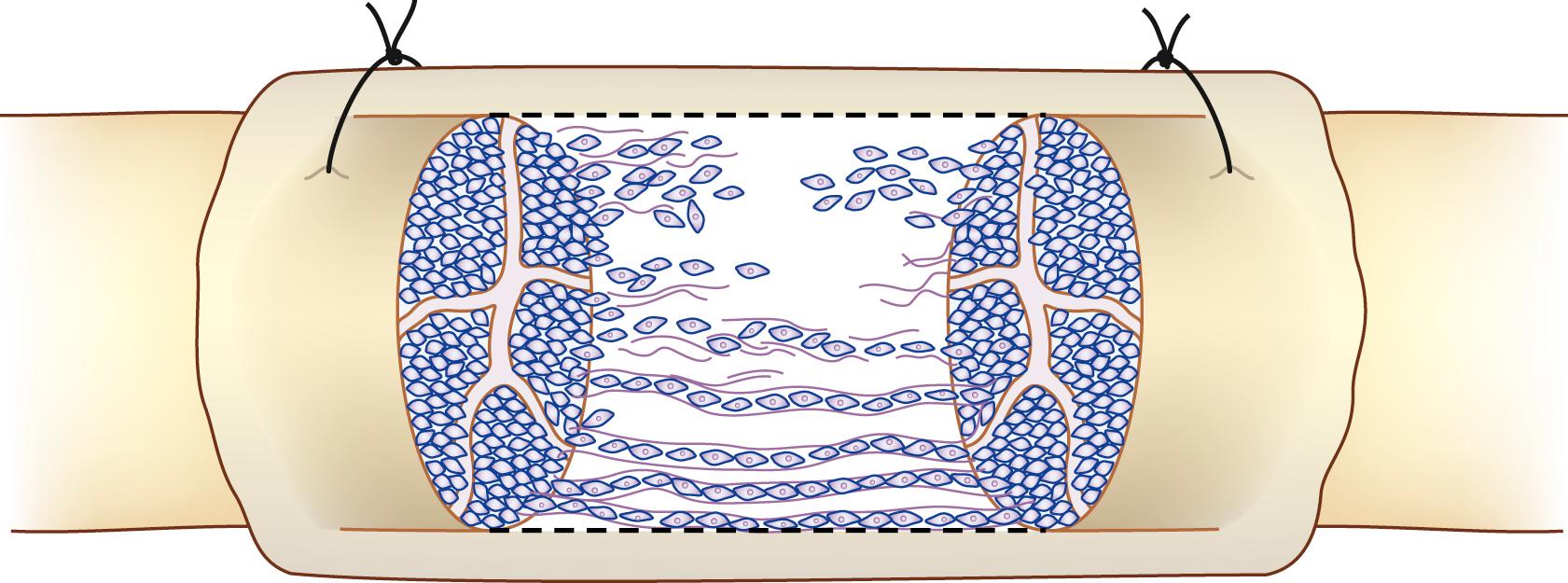
With nerve grafting, fascicular matching, when chosen by the surgeon, may not always be appropriate. However, the additional contact guidance provided to regenerating axons makes successful nerve regeneration possible over longer distances than with conduits. Donor sources for nerve grafting usually include the terminal sensory portion of the posterior interosseous nerve and the medial antebrachial cutaneous nerve for small digital nerves. The sural nerves are used for nerve gaps involving larger nerves.
If there may be a long distance between the site of nerve injury and the distal muscle target, primary nerve repair may be fruitless because muscle degeneration would have occurred by the time distal neural growth occurs. Muscle recovery is unlikely after an 18-month lapse. Thus, if nerve growth occurs at the rate of approximately 1 mm/day, a proximal motor nerve lesion more than 540 mm proximal to the hand will be doomed to failure. Hence, for proximal arm nerve and brachial plexus injuries, nerve transfers may result in a nerve repair that is closer to the muscle target. The donor nerve must be chosen so as to minimize morbidity from loss of the donor nerve. The donor nerve must be closely related to the denervated muscle so that the repair is performed much closer to the muscle target. Nerve transfers have revolutionized the repair of proximal nerve injuries so that distal muscle atrophy is minimized. For example, the classic Oberlin transfer uses part of the ulnar nerve (usually a single fascicle) for transfer to the musculocutaneous nerve and to the brachialis in the upper arm to restore elbow flexion. It is technically easy, quick, and effective. No significant motor or sensory deficits result in the territory of the ulnar nerve. This technique has become popular and is indicated for C5–6 brachial plexus lesions when C8-T1 is intact. It can also be used to neurotize a functioning free muscle transfer that may be required if the native muscles have already sustained atrophy because of prolonged denervation.
Acute vascular injuries may follow closed or penetrating trauma or iatrogenic injury. Fractures or dislocations may cause vascular injury. Indirect vascular trauma may be caused by traction injuries, which can avulse vessels, or by intimal damage or repetitive microtrauma from vibratory tools, which can lead to thrombosis.
The latter usually affects the ulnar artery in the Guyon canal at the wrist and is called the hypothenar hammer syndrome. Regardless of the cause, vascular injuries may lead to a critical compromise of circulation in the extremity. With a closed injury, the onset of symptoms may be delayed because swelling, hypotension, and intimal injury combine and result in late thrombosis and vascular insufficiency.
After an acute arterial injury, symptoms result from a combination of the adequacy of collateral circulation, posttraumatic sympathetic tone, and vasomotor control mechanisms. Patients with an upper extremity arterial injury who have adequate collateral circulation and normal vasomotor control may have minimal symptoms, so reconstruction is not necessarily mandatory and the injury can be treated with simple arterial ligation. If there is a noncritical arterial injury, such as to the radial artery alone, reconstruction may be advocated to restore parallel flow in case of future arterial injury, to enhance nerve recovery, to facilitate healing, and to prevent cold intolerance. However, the reported patency rate, even with microvascular techniques for single-vessel repairs, varies from 47% to 82%. The following injuries are optimally managed by vascular repair and reconstruction: axillary or brachial artery injury; combined radial and ulnar artery injury; and radial or ulnar artery injury associated with poor collateral circulation. Relative indications for repair of a noncritical vascular injury are extensive distal soft tissue injury, technical ability to achieve repair without compromising the patient’s well-being, and a combined vascular and neural injury. The need for arterial reconstruction necessitates assessing the adequacy of collateral circulation; this is based primarily on initial clinical judgment. However, the final decision regarding arterial reconstruction is often made in the operating room after exploration. Once the injured structures have been isolated, potential bleeding sites have been controlled, and hematoma has been evacuated, the distal extremity can be assessed more adequately. At this time, lacerated vessel ends are controlled by atraumatic vascular clamps and a tourniquet can be released. Capillary refill and perfusion of the distal extremity can then be assessed, as can backflow from the distal lacerated vessel ends. Digital blood pressure can be quantified with a sterile Doppler probe and cuff; a digital brachial index of 0.7 or greater suggests adequate perfusion. If there is poor collateral flow, arterial reconstruction is performed. At this time, standard of care does not require arterial repair of isolated noncritical vessels. In combined radial and ulnar artery injuries, one or both vessels are reconstructed. If possible, both vessels are repaired.
Muscles often swell after prolonged periods of ischemia. This can lead to an increase of pressure within the closed compartment of the forearm, resulting in a compartment syndrome. It is thus the practice of most surgeons to perform a routine fasciotomy to decompress the forearm compartment after a true revascularization procedure has been performed. During the period of ischemia to the muscles, there may be a buildup of lactic acid. Furthermore, myonecrosis might occur. Restoration of circulation to such a limb can cause a sudden flooding of the circulation with myoglobin, lactic acid, and other toxic substances. This is called reperfusion syndrome and can lead to multiorgan failure, especially affecting the renal and cardiac systems.
It can often be frustrating for the novice general surgeon to be told by a replantation surgeon in the middle of the night that a consultation was obtained inappropriately or not soon enough. There are general indications for the replantation of amputated parts, but the overriding decision is still to save life before limb. Although patients and family members may desire replantation, and in some cases have even been promised it by members of the primary team, it is not performed in patients with severe associated medical problems or injuries. Replantation is also generally not considered under the following circumstances ,
Severe crush or multilevel injury of the amputated part
A psychotic patient who has willfully self-amputated the part
Amputation of a single digit proximal to the FDS distal insertion (zone 2), except for single-digit amputations in children or those with a demanding profession (e.g., a musician)
Amputation in patients with severely atherosclerotic arteries (sometimes this can be determined only when the vessels are explored in the operating room).
Indications for replantation of amputated parts are as follows:
Whenever possible, for a thumb amputation (it provides >40% of the overall hand function)
Single digits that have been amputated distal to the FDS insertion (e.g., a manual worker may likely desire revision of amputation and desires to return to work quickly)
Multiple injured digits
Most amputations in children, including single-digit amputations
Guillotine-sharp clean amputations at the hand, wrist, or distal forearm.
Replantation is the reattachment of the part that has been completely amputated. Revascularization requires reconstruction of vessels in a limb that has been severely injured or incompletely severed in such a way that vascular repair is necessary to prevent distal necrosis, but some soft tissue (e.g., skin, tendon, nerve) is still intact. Revascularization generally has a better success rate than replantation because venous and lymphatic drainage may be intact.
Minor replantation is a reattachment at the wrist, hand, or digital level, whereas major replantation is performed proximal to the wrist. This clinical distinction exists because in the case of a major replantation, ischemic time is crucial to the viability of muscle and to functional outcome. Ischemic muscle may result in myonecrosis, myoglobinemia, and infection, which may threaten the patient’s life (as well as limb). There are three types of amputations:
Guillotine amputation, whereby the tissue is cut with a sharp object and is minimally damaged
Crush amputation, in which a local crushing injury can be converted into a guillotine injury simply by debriding back the edges, although this may not be possible in a diffusely crushing amputation
Avulsion amputation, which is the most unfavorable type for replantation because structures are injured at different levels Avulsion amputation may occur, for example, with a so-called ring avulsion injury. The extensor tendons are shredded, flexor tendons are often avulsed at the musculotendinous junctions, and nerves are stretched and may be ripped from end organs.
Ischemia time is also an important consideration in evaluating a patient for replantation. For amputated digits, more than 12 hours of warm ischemia is a relative contraindication. Promptly cooling the part to 4°C dramatically alters the ischemia factor, but even ischemia exceeding 24 hours does not necessarily preclude successful digital replantation. Ischemia time is more crucial for replantation above the proximal forearm, and reimplantation is not considered after more than 6 to 10 hours of warm ischemia time. Single digits in adults, other than the thumb in zone 2, are generally not reattached because of the consequent adverse overall functional result on the hand with a single stiff finger.
Amputation is not an outmoded operation; rather, it is necessary in a patient in whom replantation might not be indicated. When primary amputation is performed, the stump is preserved with as much length as possible. An exception might be made if there is only a very short segment of proximal phalanx. A short proximal phalangeal remnant at the index finger position may serve as an impediment for thumb to middle finger prehension, and one might consider a formal ray amputation in this case to improve overall hand function. The ends of the cut nerve are cut sharply and allowed to retract to minimize the occurrence of painful neuromas at the amputation tip. Tendons are also divided sharply and allowed to retract. The practice of suturing flexor and extensor tendons over the ends of the middle, ring, or small finger stump seriously impairs the motion of the uninjured fingers because of the common origin of the flexors. There will be an active flexion deficit in the uninjured digits, the quadriga syndrome; this is corrected simply by release of the flexor tendon remnant at the injured amputated digit.
If it is anticipated that the amputated part will be considered for replantation, it is critical to transport the patient and the part in an appropriate manner. The amputated part is placed in a clean, dry, plastic bag, which is sealed and placed on top of ice in a Styrofoam container. This keeps the part sufficiently cool at 4°C to 10°C without freezing. The amputated part is wrapped in a lightly moistened saline gauze to prevent tissue drying.
With only a few minor variations, the sequence of replantation has been standardized. Preliminary exploration of the distal amputated part under a microscope by an initial surgical team not only determines whether a replantation is technically feasible but also can be started while the patient is being prepared for the operating room. Bone shortening allows skin to be debrided back to where it is free of contusion and direct tension-free closure can be achieved. In the thumb, bone shortening is minimized to less than 10 mm. The order of repair is usually bone, tendons, muscle units, arteries, nerves, and finally veins. Establishment of arterial flow before venous flow clears lactic acid from the replanted part. The functional veins can now also be detected by spurting bleeding. However, blood loss must be closely monitored.
For major replantations, reestablishing arterial circulation as rapidly as possible is crucial to limiting ischemia time. A dialysis shunt or carotid shunt may be placed between the arterial ends. Intermittent clamping of the shunt may be necessary to restrict blood loss. In the upper extremity, bone shortening can be aggressive to achieve primary skin closure and primary nerve repair. Judicious use of anticoagulants may enhance the success of replantation. Topical application of 2% lidocaine or papaverine may help relieve vasospasm. Postoperative dressings consist of nonadherent mesh gauze, loose flap gauze, and a plaster splint, with postoperative elevation to minimize edema and venous congestion. The patient’s room must be kept warm, and smoking is forbidden postoperatively. Aside from antibiotics and analgesics, one aspirin tablet daily for its retarding effect on platelet aggregation is suggested. Postoperative monitoring is done hourly to assess color, pulp turgor, capillary refill, and digital temperature.
Pain, swelling, limited motion, and deformities suggest the presence of a fracture or dislocation. Standard anteroposterior and lateral radiographs may miss some fractures and dislocations, and multiple views may be necessary to establish the exact diagnosis. Fractures may be rotated, angulated, telescoped, or displaced. Angulation is described by the direction in which the apex of the fracture is pointing, and displacement is described by the direction of the distal fragment. Fractures may be open or closed, depending on whether a wound is involved. They may also be complete, incomplete, or comminuted (more than two pieces). Fractures are also described by their pattern; they may be transverse, longitudinal, oblique, or spiral. Open fractures need to be thoroughly irrigated and debrided urgently. Displaced fractures or dislocations are repositioned as soon as possible. A dislocation is described according to the direction of displacement of the distal bone in the involved joint. The separation of joints may be complete or incomplete (subluxed), depending on the severity of the capsular injury.
Displaced fractures or dislocations are repositioned as soon as possible to decrease soft tissue injury, to decompress nerves that might be stretched, and to relieve kinking of blood vessels. Good bone contact and stability are necessary for fractures to heal. Indications for surgery include inability to obtain and maintain closed reduction, open fractures, or significant bone loss that requires bone grafting. ( Table 70.4 ).
| Method of Fixation | Advantages | Disadvantages |
|---|---|---|
| Kirschner wires | Come in varying diameters Can be applied percutaneously or open Second surgery not required for removal Require less soft tissue dissection than plates and screws |
Pins can loosen Cannot provide rigid fixation Soft tissue may be transfixed (but can be avoided by careful placement) Infection can occur along pin tracks |
| Screws | Have high stability Allow early finger mobilization |
Frequently require open approach (although not always) |
| Plates | Can be used when fracture line is not oblique enough for screws Allow early finger mobilization |
Require open approach Require extensive soft tissue dissection Have relatively high profile and may be palpable through the dorsum of fingers and hand May promote extensor tendon adhesions by their relative bulk and dissection required for placement |
A distinction between functional stability and rigid stability must be discussed prior to understanding the different fixation methods. American orthopedic principals for rigid fixation require anatomic reduction, functionally stable fixation, minimally traumatic dissection, and early active motion. This kind of rigid fixation requires direct visualization of the bone segments and can be accomplished with either a plate and screws, lag screws, or an external fixator. Functional stability allows for micromotion to occur at the fracture site. A callous forms at the gap and is replaced with bone during the healing process. Functional stability is generally accomplished with Kirschner wires plus a splint or cast.
In the distal upper extremity, rigid internal fixation may at first glance seem like an attractive option to enable early postoperative movement. However, in the fingers especially, the soft tissue disruption that is necessary and the hardware itself may actually mitigate against those potential advantages leading to increase scarring and plate irritation in an already confined space between the plate and the bone. Thus, the simplicity of Kirschner wire fixation, especially if done percutaneously, although not providing rigid fixation, may be the most suitable method.
Intraarticular fractures require accurate reduction to preserve motion and to minimize the risk for later development of arthrosis. Persistent rotational and significant lateral angular deformities generally do not remodel with time; these can be avoided by observing the alignment of the injured fingers compared with adjacent digits while passively and gently flexing them into a fist after reduction is attained. If they do not fit comfortably adjacent to each other and do not point toward the distal pole of the scaphoid, a fresh attempt at reduction must be performed. A thorough neurovascular examination is always performed before and after fracture reduction has been completed.
Fractures of the distal phalanx are the most frequent hand fractures, representing 50% of all hand fractures. Most result from crush injuries with associated nail bed injuries. Precise reduction is generally not required, and treatment typically consists of splinting alone.
Most closed mallet fractures can be managed by splinting the DIP joint in extension, provided the fracture involves less than 50% of the joint surface and is not associated with DIP joint subluxation. The splint must remain on 24 hours a day every day for 6 weeks. There are occupations or other situations where this may be impossible. In these situations, a buried oblique Kirschner wire can be placed to maintain reduction; however, this requires a second surgery for removal and may result in worse outcomes.
A so-called jersey finger is an avulsion fracture of the insertion of the FDP tendon into the distal phalanx. It occurs after a pull of the FDP against resistance as can occur when a footballer catches onto the jersey of an opponent. On occasion, the avulsed fragment may lie as far proximally as the palm. This fracture fragment generally requires open reduction and internal fixation. If the tendon has migrated into the palm, the vincula blood supply has likely been compromised and the tendon will likely necrosis if not operated on within a few days.
Fractures may involve the head, neck, shaft, or base of the respective bone. Head and base fractures may be intraarticular. A middle phalangeal shaft fracture is displaced according to the forces exerted by the insertions of the FDS and central slip mechanism. If the fracture lies distal to the FDS insertion, the proximal fragment is flexed by this muscle, resulting in a volar angulation. In contrast, if the fracture is proximal to the FDS insertion, the proximal fragment is extended by the central slip, whereas the distal part is flexed by the FDS. This results in a dorsal angulation. Most shaft fractures of the proximal phalanx tend to angulate volarward because the interossei reflect the proximal fragment and the central slip, through the PIP joint, extends the distal fragment. Displaced and unstable shaft fractures require open reduction followed by fixation with Kirschner wires or screws. The small size of the phalanges make plating quite difficult.
Fractures of the metacarpal can occur at the head, neck, shaft, or base. Fractures at the head will involve the metacarpal phalangeal joint. Fractures at the neck are generally volarly angulating given the strong flexion forces of the flexor digitorum tendons. Shaft fractures can have a variety of configurations that determine stability and the best plan for fixation. Finally, metacarpal base fractures will involve the carpometacarpal joint and can be associated with joint dislocations.
Dorsally angulated fractures at the neck of the little finger metacarpal, the so-called boxer fracture, do not require reduction if there is no scissoring or angulation. The mobility of the carpometacarpal joint will compensate for higher degrees of dorsal angulation in the small and ring fingers. The index and middle finger metacarpals are less mobile than the ring and little finger metacarpals. Therefore, only around 10 to 20 degrees of angulation can to be tolerated at the index or middle fingers.
These bones are larger than the phalanges and can tolerate a plate and screw construct if needed; however, percutaneous Kirschner wire placement is still preferred. Internal fixation can be achieved with lag screws, or plate and screws, depending on the fracture pattern configuration. Lag screws can be used in long oblique fractures or spiral fractures that allow one to have at least two adequately sized screws along the fracture line.
Oblique fractures at the base of the thumb metacarpal (Bennett fracture) result in the small proximal fragment’s being held in position by the volar oblique ligament to the trapezium. The remaining portion of the thumb metacarpal is displaced dorsally and radially because of the pull of the APL tendon ( Fig. 70.31 ). These fracture fragments must be properly reduced and secured with internal fixation with Kirschner wires or a screw. Comminuted fractures at the base of the thumb metacarpal (Rolando fracture) are infrequently treated by closed reduction. If the fragments are large and badly displaced, an open reduction is indicated to ensure accurate restoration of the joint surface at the base of the thumb metacarpal.
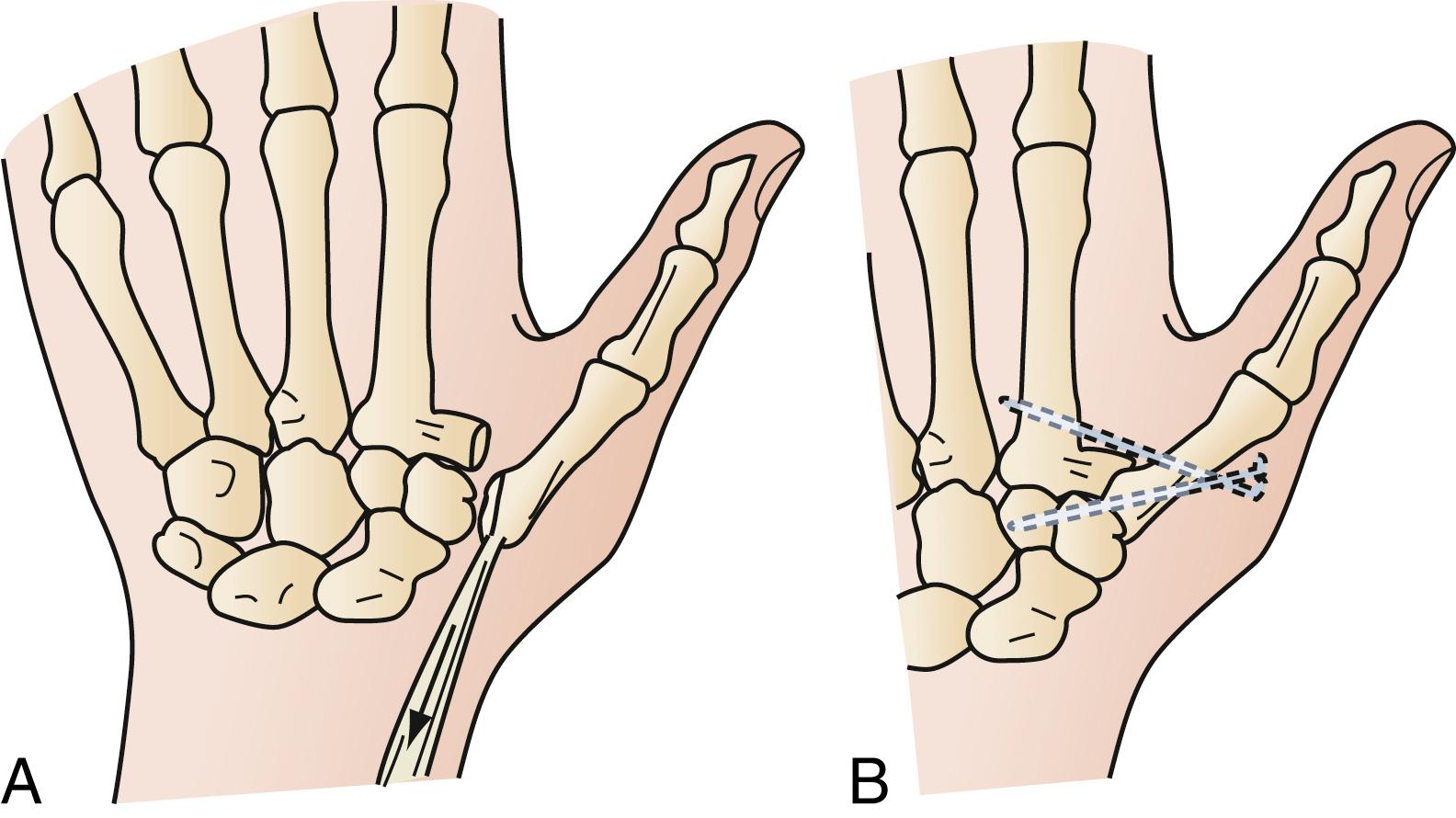
Fractures of the shaft of the thumb metacarpal tend to become displaced by the opposing muscle forces of the abductor and adductor on the proximal and distal fragments, respectively. Even nondisplaced fractures may become progressively more displaced and angulated over time, necessitating an internal fixation. If initial splint immobilization is chosen for a nondisplaced thumb metacarpal fracture, close follow-up is required to detect the earliest signs of displacement and instability. Fracture at the base of the little finger metacarpal is analogous to Bennett fracture of the thumb and is sometimes called a reverse Bennett fracture. This results in a fracture-dislocation, with the deforming force being the insertion of the ECU tendon.
The scaphoid is the most common carpal bone fracture and accounts for approximately 60% of all carpal injuries. Clinical examination shows tenderness over the anatomic snuffbox and over the scaphoid tubercle. If a scaphoid fracture is suspected, the initial radiographic examination includes not only the standard three views of the wrist but also a scaphoid view, which is a posteroanterior image with the wrist in full ulnar deviation ( Fig. 70.32 ). Frequently, immediate postinjury radiographs may not reveal a fracture. CT or MRI may help in these cases, or one may elect to apply a splint and to repeat the radiographs in 2 weeks.
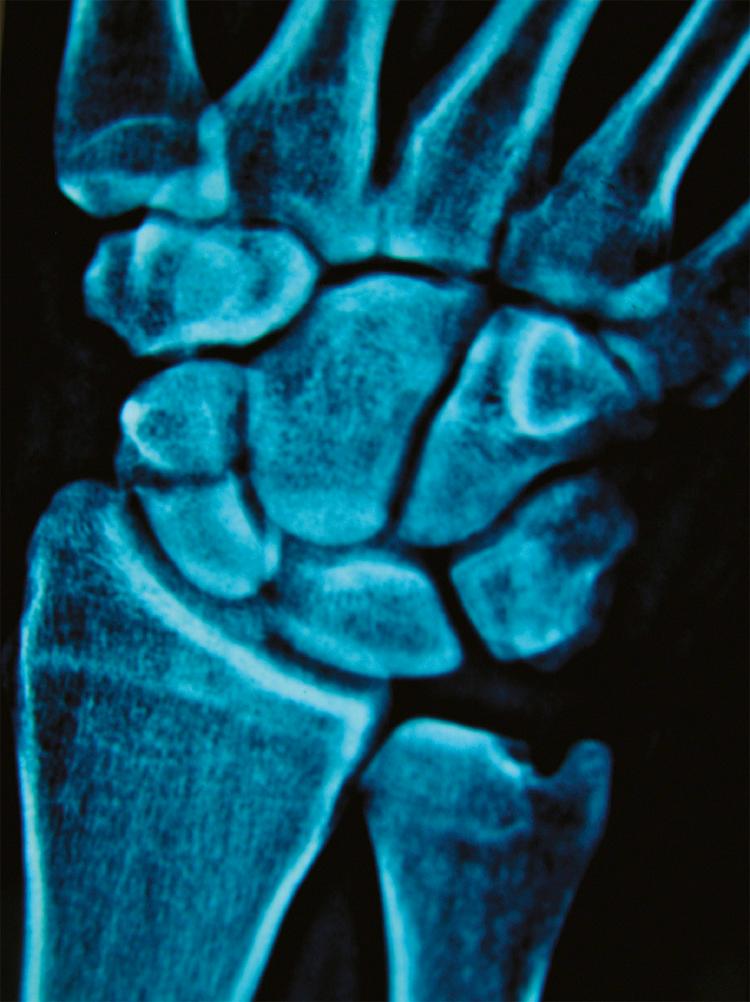
Treatment of a nondisplaced scaphoid fracture is with a short or long arm cast that includes the thumb. The thumb spica cast is maintained for 6 weeks, followed by a short arm cast until radiographic healing has occurred. There has been a trend toward percutaneous screw fixation of even, nondisplaced scaphoid fractures.
Displaced scaphoid fractures require open reduction with internal fixation, generally using a compression screw. Complications with inadequately treated scaphoid fractures are notorious. The blood vessels enter the scaphoid mainly through its distal half, and fractures through the waist of the scaphoid may deprive the proximal half of its blood supply, leading to avascular necrosis of the proximal pole of the scaphoid. Nonunion also occurs with relative frequency, and these cases need to be treated with cancellous bone grafting or even a pedicle vascularized bone graft. Early diagnosis of scaphoid fractures is essential so that appropriate treatment can be instituted to reduce the risks for these complications. Modern cannulated compression screws, intraoperative fluoroscopy, and arthroscopy have allowed minimally invasive percutaneous fixation of some of these scaphoid fractures, resulting in a trend toward more aggressive surgical treatment of these fractures.
The Salter-Harris classification describes five types of epiphyseal injuries ( Fig. 70.33 ). Pediatric bones are still growing and thus permit a greater degree of remodeling. Hence, moderate angular and translational displacement of fractures tends to correct with age. However, rotational deformities never correct in the hand and are totally unacceptable, even in children. Implants that cross the epiphysis must have minimal potential for damage. Hence, smooth Kirschner wires are generally used for the fixation of pediatric skeletal injuries, and threaded screws are usually avoided.
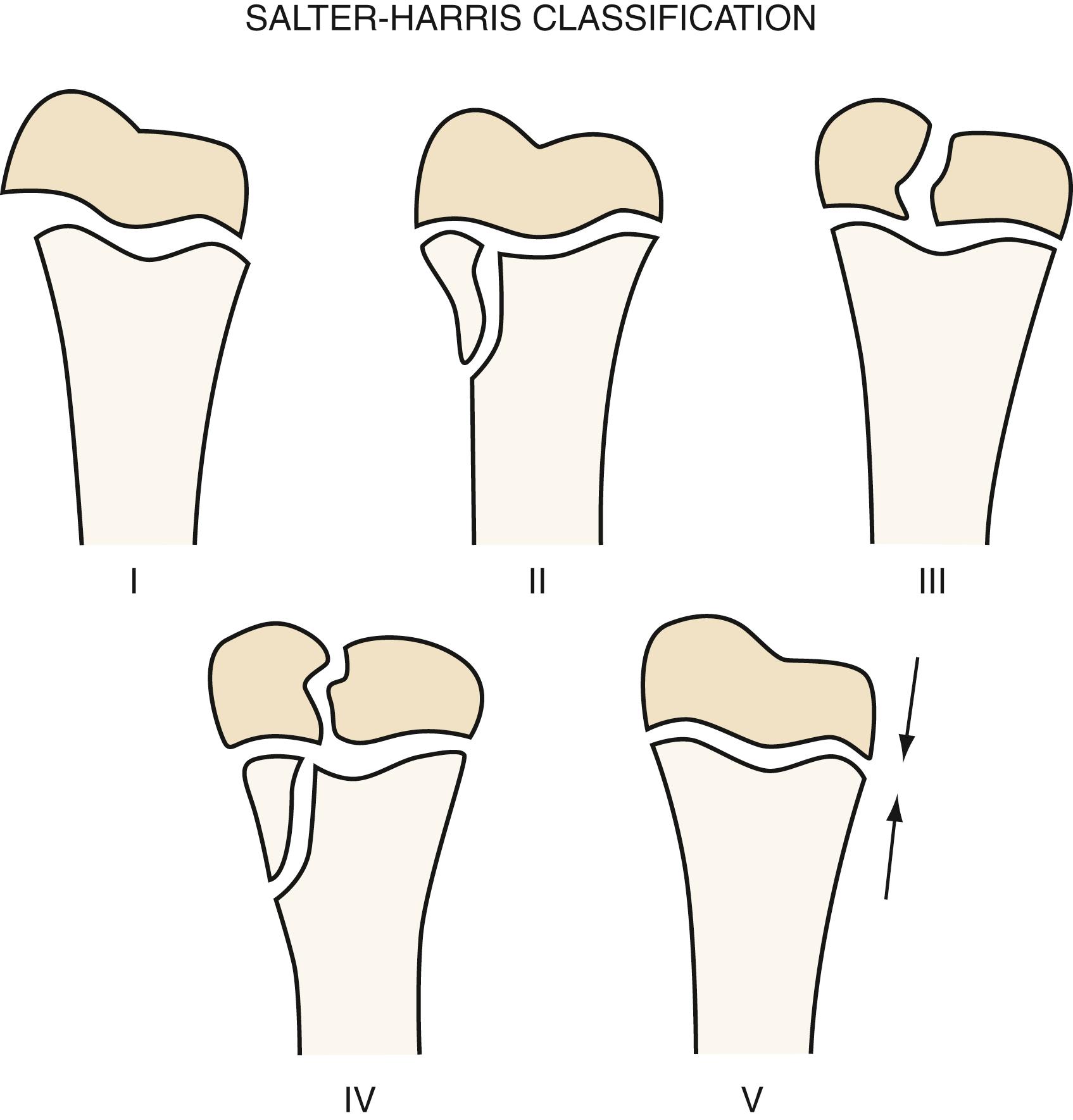
Dislocations are more frequently seen at the PIP joint. A closed dislocation of the PIP joint can frequently be managed by closed reduction and splinting. If the joint is unstable after reduction, it needs exploration for collateral ligament repair. The most common type of PIP joint dislocation is a dorsal dislocation. A PIP joint volar dislocation is often associated with a tear in the triangular ligament of the extensor mechanism through which the head of the proximal phalanx protrudes and becomes trapped. Attempts at closed reduction fail because they tighten the fibers of the lateral bands and central slip around each side of the protruding proximal phalangeal neck; these injuries often require open reduction with repair of the extensor tear.
Palmar dislocations of the head of the index finger metacarpal often require open reduction. The head of the metacarpal becomes trapped between the superficial transverse metacarpal ligament, flexor tendons, and lumbrical muscles, whereas the volar plate becomes trapped between the metacarpal head and base of the proximal phalanx. Attempts at closed reduction are fruitless because of the entrapment resulting from this arrangement.
MP joint dislocation of the thumb often results from jamming it in a radial direction, thus tearing the ulnar collateral ligament. The ulnar collateral ligament may pull proximally and come to rest dorsal to the extensor hood (Stener lesion; Fig. 70.34 ). It cannot heal spontaneously because the ulnar collateral ligament is prevented from reattaching to bone. This so-called ski pole injury may then require operative repair. Stress radiography, sometimes able to be performed only after the digit is anesthetized with a metacarpal block, may be required to facilitate diagnosis of a complete ulnar collateral ligament injury of the thumb metacarpal joint.
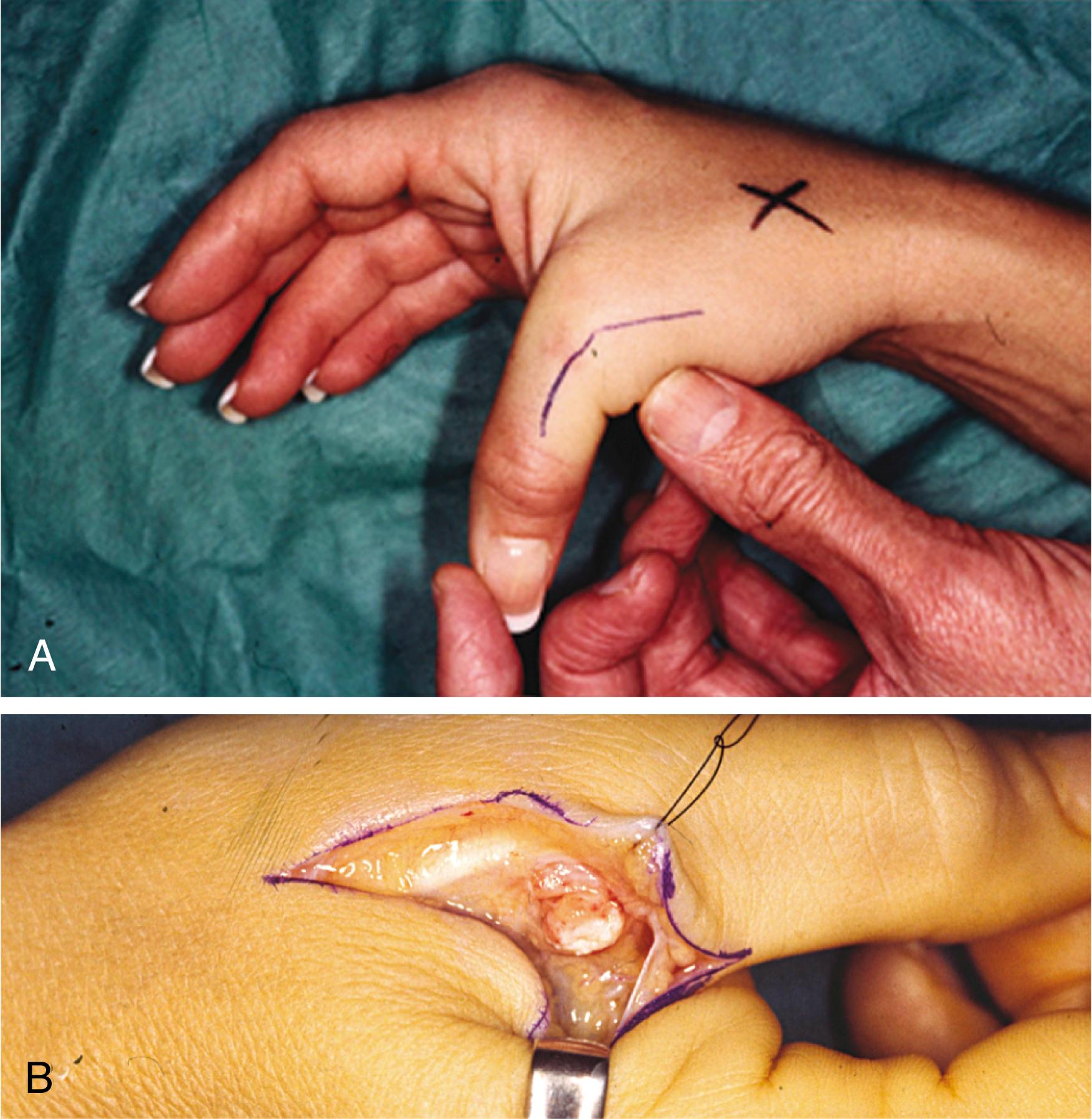
In addition to soft tissue, tendon, and nerve reconstruction, there may also be a deficiency of bone in wounds resulting from injury, trauma, oncologic resection, and debridement involving infection. Frequently, staged debridements are required before definitive reconstruction.
The technique used to reconstruct a bone gap depends on the size of the gap, the patient’s concomitant injuries, and the availability of specialized techniques such as microsurgery or bone distraction and even anatomic location. For example, hand and wrist injuries require different techniques than major limb bones. The broad options for reconstructing bone defects are nonvascularized bone grafting (cancellous or cortico-cancellous strut), vascularized bone flaps, bone transportation via distraction osteogenesis, and amputation.
Bone grafts and flaps rely on the principals of osteoconduction, osteoinduction, and osteogenesis to achieve bone healing and consolidation. Osteoconduction is when a graft serves as a scaffold for the ingrowth of blood cells and osteoblasts from the recipient site. This occurs with a processed cadaver bone graft for example. A cortical bone graft may have the theoretical possibility of providing structural support but heals largely by osteoconduction in a process of “creeping substitution.” Any living cells in such a bone graft may be too remote from the recipient blood supply to provide much capacity for osteogenesis.
Osteoinduction is when the graft encourages progenitor cells in the recipient site to differentiate into osteoblasts. Finally, osteogenesis is when the donor graft carries progenitor cells along with it that differentiate into osteoblasts after transfer ( Table 70.5 ).
| Osteoconduction | Osteoinduction | Osteogenesis | |
|---|---|---|---|
| Cancellous bone graft | - | + | + |
| Cortical bone graft | + | - | - |
| Vascularized bone flap | + | + | + |
A cancellous bone graft has living cells that are close to the recipient blood supply and do have an inherent osteogenic potential. Because of the sponginess of a block of cancellous bone or multiple chips of bone grafts, there is limited osteoconduction.
A vascularized bone flap has the advantage of all three properties. These have been loosely called vascularized bone grafts, but because they have their own innate blood supply (unlike grafts), they are more correctly called bone flaps. Despite this, vascularized bone graft seems to have become a commonly used term.
Nonvascularized bone grafts have good success in clean wounds with good soft tissue coverage and a bone gap of less than 6 cm. Cortical cancellous strut grafts have a potential advantage of providing structural support. However, cancellous bone grafts may heal even substantial bone gaps if support is provided by either internal fixation (such as a locking spanning plate) or external fixation.
Donor sites for nonvascularized cancellous bone grafting heal well with a low complication rate. For small amounts, it can be taken from the distal radius through a bone window at Lister tubercle. The iliac crest provides a rich supply of cancellous bone when larger amounts are needed. ,
Cancellous bone graft can be used for even sizable bone gaps in major upper limbs bones. “Take” of the graft is enhanced by using the Masquelet technique. This technique starts with the placement of an antibiotic cement spacer in the bone gap. This can be supported with a Kirschner wire, a small plate, or external fixator depending on the size of the bone and the bone gap. A membrane forms around the spacer with maximum vascularity forming within the membrane at about 10 days. It is at this time that the membrane can be sharply incised. The cement is delivered and the space packed with cancellous bone grafts. While this was first utilized for the leg, promising results have also been reported for major upper limb bones.
Another technique is to create new bone by utilizing distraction osteogenesis. Here a frame is placed with a bar on either side of the proposed lengthening site. A fracture is then made at that site. During the initial latency phase, the bone is allowed to partially heal. During the subsequent activation phase, the arms of the frame are separated, usually by turning a screw on the external portion of the frame. As the fracture is widened, a generate is formed, which is similar to a callus, and this eventually heals into normal bone. Once the desired length is reached, the consolidation phase is initiated. This is when distraction is no longer performed and the bone is allowed to fully heal.
Vascularized bone flaps take advantage of all the aspects of bone graft healing. They do require microsurgical technique and have a more morbid donor site. However, they do have the advantages of more robust healing if the wound was previously contaminated or there is a long gap in a major limb bone. They can also be spanned in order to provide structural support. The more common donor sites are the fibula and iliac crest for large recipient sites and the medial femoral condyle for smaller sites.
Complex contaminated injuries that involve multiple structures (bone, soft tissue, tendons, nerves, and blood vessels) must be treated in a methodological and thoughtful manner to optimize functional outcome and reduce the risk of infection, flap loss, and bone nonunion.
It is also common to have associated trunk and head injuries that may need to take priority but not to the neglect of the extremity involvement. Many elbow gunshot injuries, for example, are from missile injuries to the abdomen and chest, the elbow and forearm simply got protectively placed in the way of the passing bullet on its way to the chest!
Injuries that involve multiple structures are treated systematically by breaking them down into component parts and addressing the problem in a stepwise plan. “Life before limb” but at least stabilize the limb injury before it can be addressed more completely. First, follow acute trauma life support protocols. Once the secondary survey has identified the extent of nonlife threatening injuries and necessary radiographs have been taken, extremity management begins ( Box 70.1 ).
Life over limb
Revascularization
Temporary bone fixation
Debride, debride, debride
Definitive reconstruction
If the distal part is avascular or if there is major bleeding, this must be addressed first. If a tourniquet can be placed proximal to the injury, then the use of a bloodless field is extremely helpful. This enables a more thorough assessment for debridement and identification of structures to be repaired. Vascular repair is either done by direct anastomosis or a temporary vascular shunt may be placed. In the event that a severely displaced fracture will hamper vascular repair, temporary bone fixation should be done prior to revascularization ( Box 70.2 and Fig. 70.35 ).
Revascularization
Temporary bony fixation
Soft tissue coverage
Definitive bony reconstruction
Tendon and nerve reconstruction
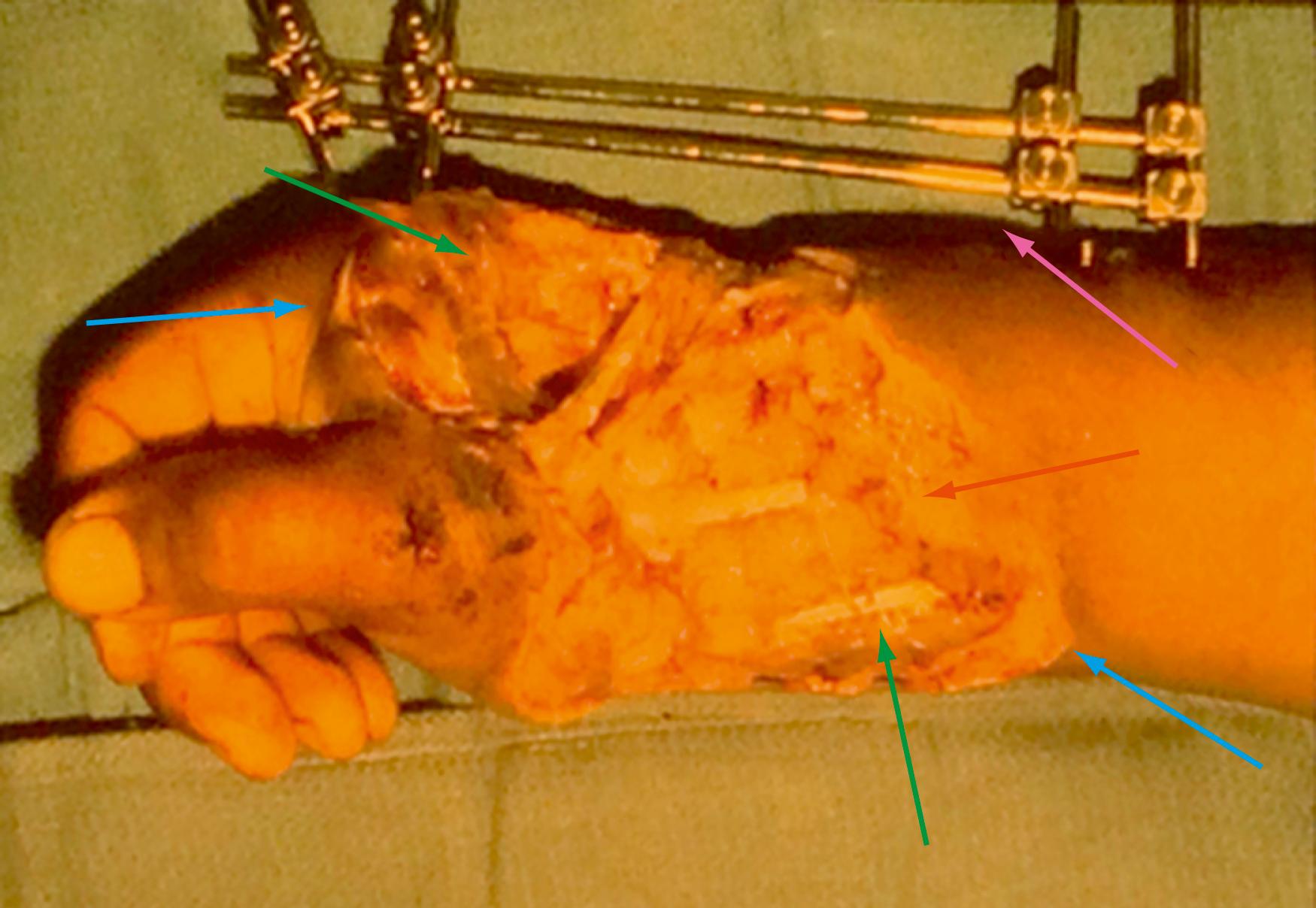
Fractures must be stabilized, either temporarily by means of external fixation or bridging spanning plates. A decision is made for bone shortening or if this is not functionally possible, then a bone gap and soft tissue space must be maintained. Bone shortening may facilitate nerve, tendon, and vessel repair by bringing the ends for the repair closer together and minimizing tension as well as closing down the soft tissue space. In the severely injured extremity, amputation may be a consideration, remembering that prosthetic utilization is much more complex for an above elbow amputation than a transradial amputation. If a decision is made for amputation, try if at all possible to preserve an elbow joint.
Adequate initial debridement is paramount, not only of embedded foreign material, but also of devitalized tissue. Antibiotic impregnated methyl methacrylate as a solid spacer or as a string of antibiotic beads can help to maintain the soft tissue space and deliver a high dose of antibiotics locally to the area. The membrane that forms around the antibiotic cement will give one a head start for bone reconstruction as well. Early and aggressive debridement remains critical. Infection will compromise any future bone or soft tissue reconstruction. Only once one has an adequately clean wound, can reconstruction be considered.
This will likely require more than one debridement. The vacuum-assisted closure (VAC) device has allowed us to temporarily cover an open wound and maintain the sterile environment while surgical planning and repeat debridements take place. For injuries more distally, the VAC dressing reduces edema, can maintain and mold the hand and wrist in a functional position. It may even help to stabilize fractures. Thus the VAC provides temporary splinting as well as a bridge to definitive soft tissue coverage and reconstruction.
Godina landmark paper in 1986 described the principals of early soft tissue wound coverage of open fractures with a cleanly debrided wound. Not only is the quality and durability of the soft tissue coverage important (such as a free or pedicled flap), but also the timing of this coverage is paramount. Extensive delay results in progression of the collagen phase of wound healing and fibrotic granulation tissue leading to callous and loss of fixation. Often bone and soft tissue reconstruction can be performed simultaneously. On occasion, if the bone is stabilized by external fixation or an antibiotic spacer, soft tissue flap reconstruction may precede the bone reconstruction.
Tendons and nerves are repaired once vascular integrity is ensured and bone fractures are stabilized. In the case of high-energy injuries, one may elect to delay tendon repairs, but severed ends should be tagged for future identification. Even if definitive tendon reconstruction is planned at a later stage, approximation of tendon ends, if possible, should be done to minimize proximal muscle belly myostatic contraction ( Fig. 70.36 ).
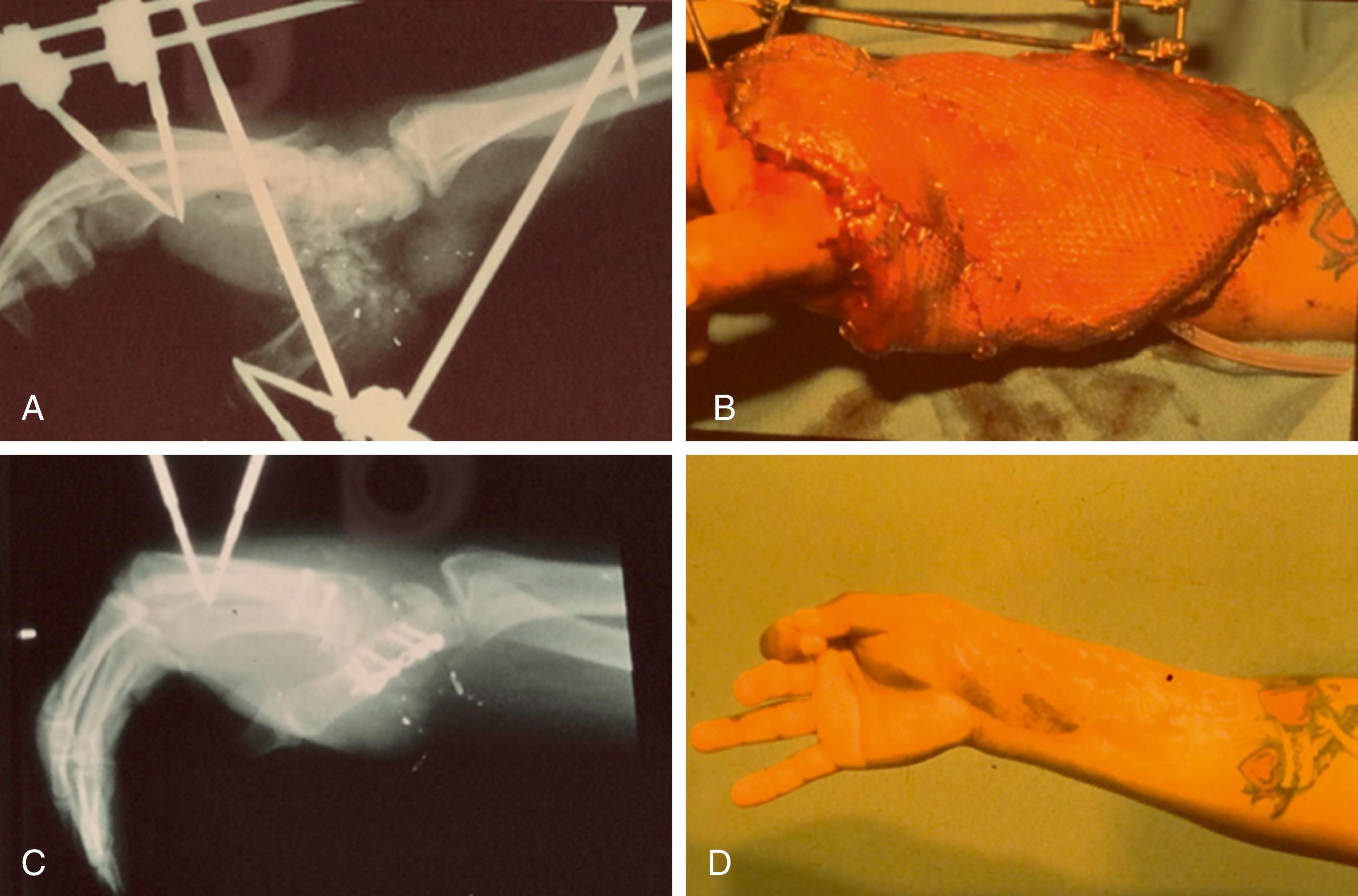
The concept of “spare parts” uses components distal to the injury for reconstruction. For example, an unsalvageable mutilated digit may be amputated, but the goal should be to at least preserve the soft tissues for pedicled flap coverage of adjacent structures. A forearm that is mangled may be cleared of bone and that soft tissue envelope used for coverage of a more proximal amputation. That distal tissue has even on occasion been used as a free flap more proximally. This concept may be especially useful in the reconstruction of damaged joints. Blood supply of these spare parts must be preserved.
Hand infections commonly present to the surgical resident covering the emergency department. When the infection is diagnosed and treated properly initially, most patients do well. The extent of deep palmar infections may often be underestimated during the early phases because the volar aspect of the hand does not show edema as readily as the dorsal aspect of the hand. Thus, if infections in the hand are not diagnosed at an early stage, infections may spread from one anatomic compartment to another along natural tissue planes. Hand infections can then result in significant morbidity and severe functional compromise if they are not appropriately diagnosed and treated ( Fig. 70.37 ). Some of the more common types of infections are discussed here.
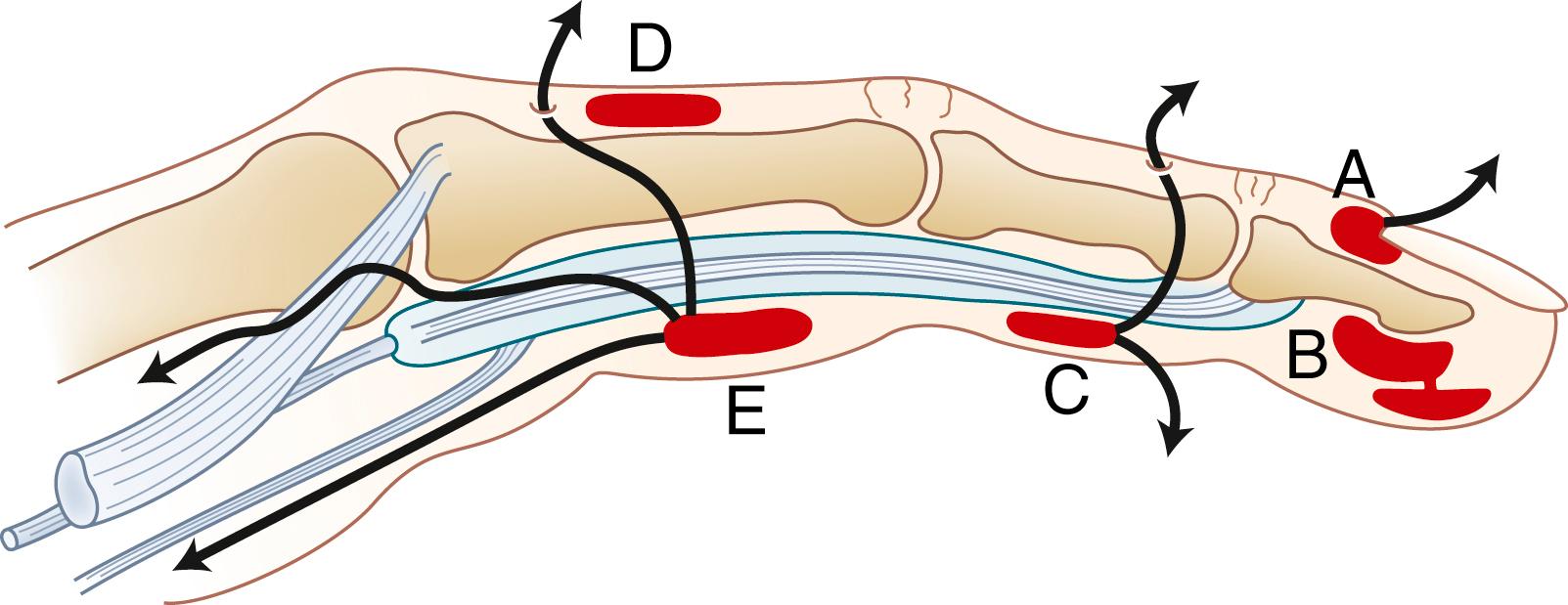
Paronychia is the most common infection of the hand; it usually results from trauma to the eponychial or paronychial region. The infection localizes around the nail base, advances around the nail fold, and burrows beneath the base of the nail. If pus is trapped beneath the nail, pressure on the nail evokes exquisite pain. The most common causative organism is Staphylococcus aureus. Early treatment is with antibiotics, preferably penicillin in combination with a β-lactamase inhibitor such as sulbactam or clavulanic acid. However, there has now been an increasing incidence of methicillin-resistant S. aureus in community-acquired infections. After an abscess develops, surgical drainage is required. The surgical approach to an acute paronychia depends on the extent of the infection. Incisions may not be necessary. A Freer elevator is used to lift approximately 25% of the nail adjacent to the infected perionychium, extending proximally to the edge of the nail. This portion of the nail is transected, and gauze packing is inserted beneath the nail fold. A single incision to drain the affected perionychium also allows elevation of the eponychial fold when both eponychium and paronychium are involved ( Fig. 70.38 ).
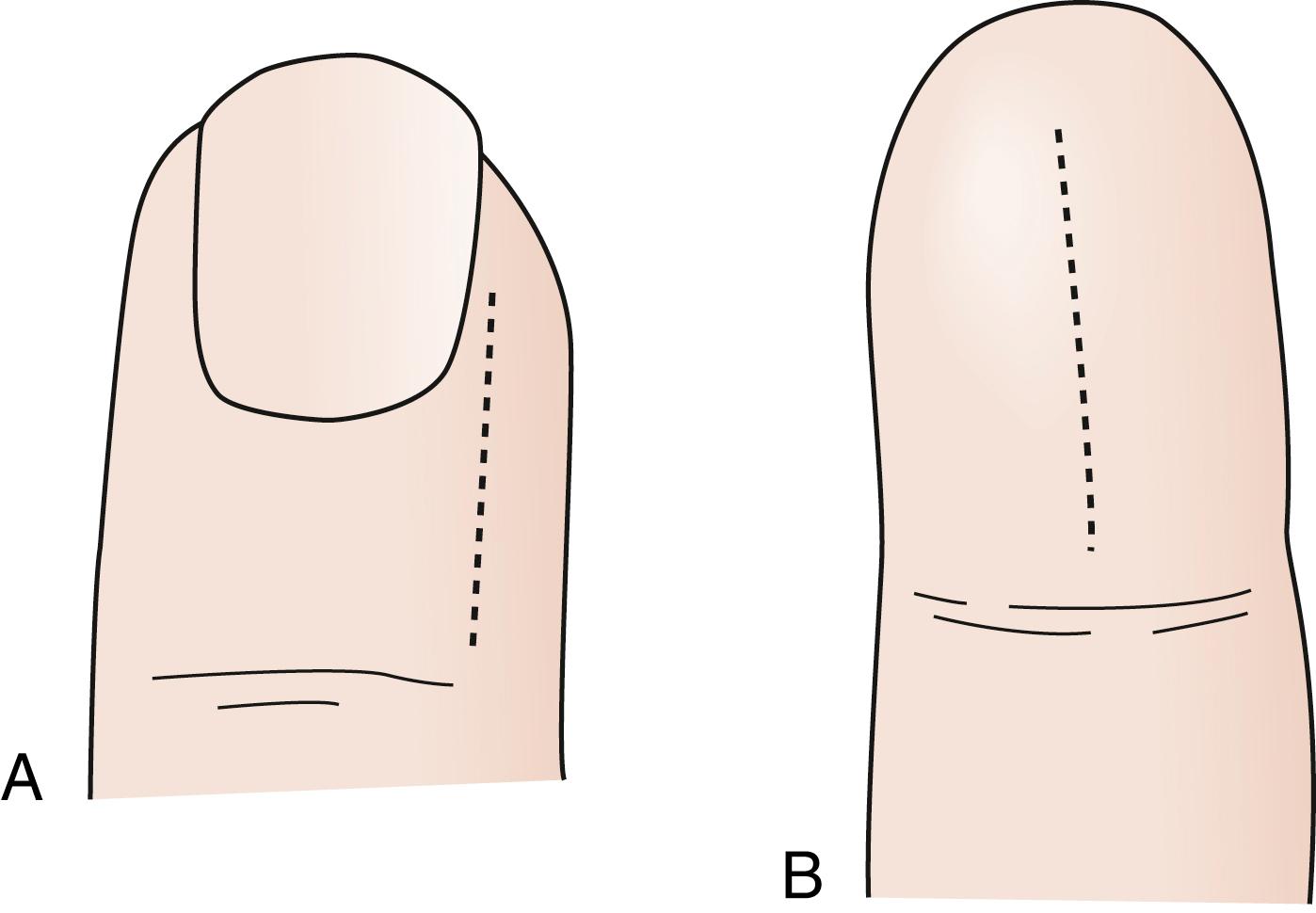
Infections of intermediate-depth spaces are pulp space infections (felons) and deep web space infections. The pulp space infections may involve the terminal, middle, or proximal volar pulp spaces and may result from direct implantation with a penetrating injury or may represent spread from a more superficial subcutaneous infection. The volar pulp of the distal digital segment is a fascial space closed proximally by a septum joining the distal flexion crease to the periosteum, where the long flexor tendon is inserted. This space is also partitioned by fibrous septa. Tension in the distal digital segment can become so great that the arteries to the bone are compressed, resulting in gangrene of the fingertip and necrosis of the distal 75% of the terminal phalanx. With infection of the digital pulp space, one must not wait for fluctuance before making the decision for surgery because of the danger of ischemic necrosis of the skin and bone. Clinical diagnosis is made by the rapid onset of throbbing pain, swelling, and exquisite tenderness of the affected pulp space. Surgical drainage is required. A single volar or unilateral longitudinal incision may be used ( Fig. 70.38 ). Postoperative care includes packing of the wound and elevation of the extremity. Use of antibiotics is guided by the results of Gram staining. Similar to a paronychia, S. aureus is the most common causative agent. Spread from a pulp space infection may move into a joint space or underlying bone or burst through the septum proximally to involve the rest of the finger. More proximally, a pulp space infection at the base of the finger can travel through the lumbrical canal into the palm to create a deep palmar space infection.
Web space abscesses result from direct implantation or spread from a pulp space. An inflamed and tender mass in the web space separates the fingers. There is loss of the normal palmar concavity, with a widened space between the fingers. Dorsal swelling is present and must not be mistaken for the infection site. A surgical incision is placed transversely across the web space, and a longitudinal counterincision may be placed dorsally between the bases of the proximal phalanges; a generous communication is established between these two incisions ( Fig. 70.39 ).
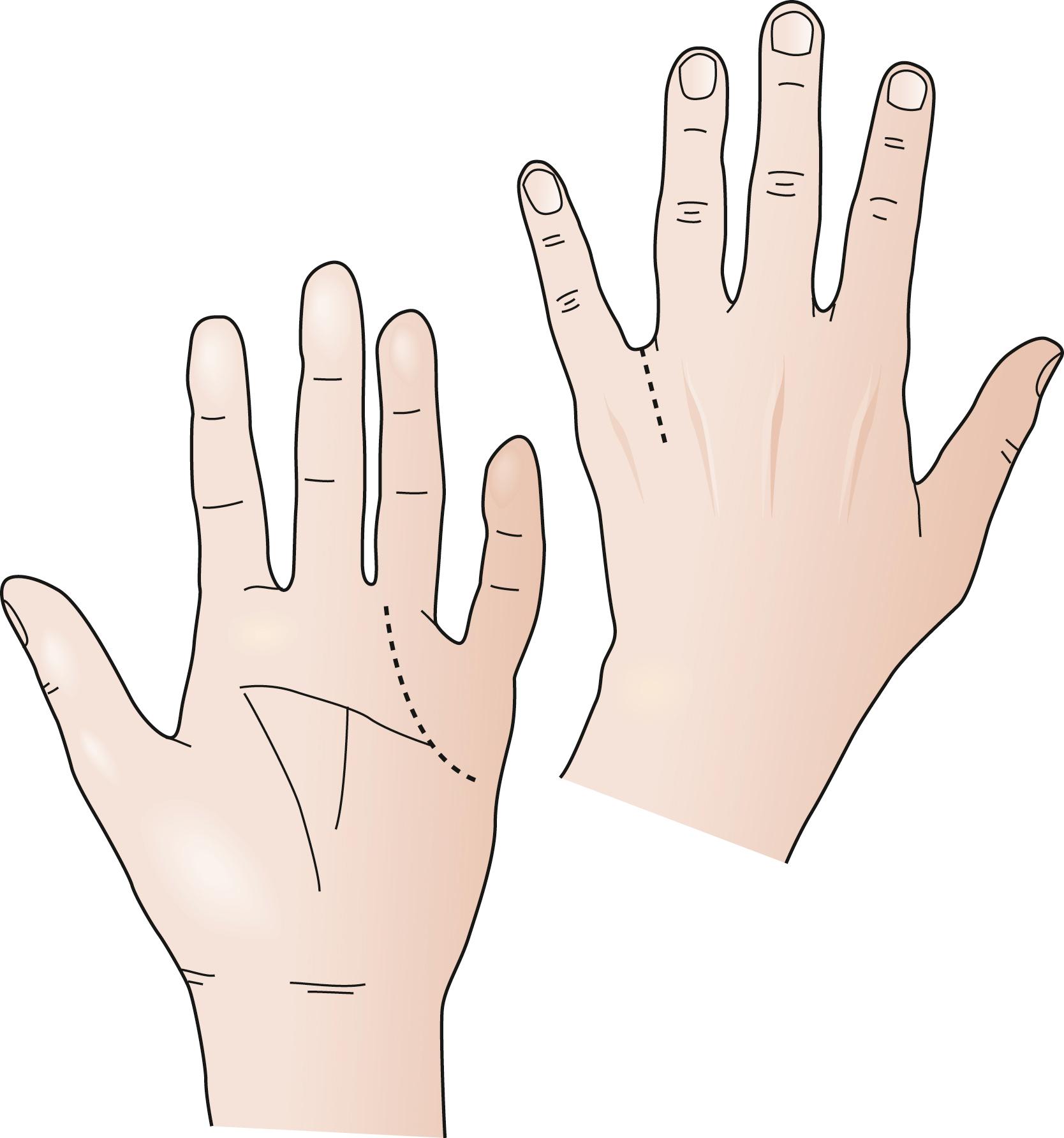
Become a Clinical Tree membership for Full access and enjoy Unlimited articles
If you are a member. Log in here